

Thesis Statements
What this handout is about.
This handout describes what a thesis statement is, how thesis statements work in your writing, and how you can craft or refine one for your draft.
Introduction
Writing in college often takes the form of persuasion—convincing others that you have an interesting, logical point of view on the subject you are studying. Persuasion is a skill you practice regularly in your daily life. You persuade your roommate to clean up, your parents to let you borrow the car, your friend to vote for your favorite candidate or policy. In college, course assignments often ask you to make a persuasive case in writing. You are asked to convince your reader of your point of view. This form of persuasion, often called academic argument, follows a predictable pattern in writing. After a brief introduction of your topic, you state your point of view on the topic directly and often in one sentence. This sentence is the thesis statement, and it serves as a summary of the argument you’ll make in the rest of your paper.
What is a thesis statement?
A thesis statement:
- tells the reader how you will interpret the significance of the subject matter under discussion.
- is a road map for the paper; in other words, it tells the reader what to expect from the rest of the paper.
- directly answers the question asked of you. A thesis is an interpretation of a question or subject, not the subject itself. The subject, or topic, of an essay might be World War II or Moby Dick; a thesis must then offer a way to understand the war or the novel.
- makes a claim that others might dispute.
- is usually a single sentence near the beginning of your paper (most often, at the end of the first paragraph) that presents your argument to the reader. The rest of the paper, the body of the essay, gathers and organizes evidence that will persuade the reader of the logic of your interpretation.
If your assignment asks you to take a position or develop a claim about a subject, you may need to convey that position or claim in a thesis statement near the beginning of your draft. The assignment may not explicitly state that you need a thesis statement because your instructor may assume you will include one. When in doubt, ask your instructor if the assignment requires a thesis statement. When an assignment asks you to analyze, to interpret, to compare and contrast, to demonstrate cause and effect, or to take a stand on an issue, it is likely that you are being asked to develop a thesis and to support it persuasively. (Check out our handout on understanding assignments for more information.)
How do I create a thesis?
A thesis is the result of a lengthy thinking process. Formulating a thesis is not the first thing you do after reading an essay assignment. Before you develop an argument on any topic, you have to collect and organize evidence, look for possible relationships between known facts (such as surprising contrasts or similarities), and think about the significance of these relationships. Once you do this thinking, you will probably have a “working thesis” that presents a basic or main idea and an argument that you think you can support with evidence. Both the argument and your thesis are likely to need adjustment along the way.
Writers use all kinds of techniques to stimulate their thinking and to help them clarify relationships or comprehend the broader significance of a topic and arrive at a thesis statement. For more ideas on how to get started, see our handout on brainstorming .
How do I know if my thesis is strong?
If there’s time, run it by your instructor or make an appointment at the Writing Center to get some feedback. Even if you do not have time to get advice elsewhere, you can do some thesis evaluation of your own. When reviewing your first draft and its working thesis, ask yourself the following :
- Do I answer the question? Re-reading the question prompt after constructing a working thesis can help you fix an argument that misses the focus of the question. If the prompt isn’t phrased as a question, try to rephrase it. For example, “Discuss the effect of X on Y” can be rephrased as “What is the effect of X on Y?”
- Have I taken a position that others might challenge or oppose? If your thesis simply states facts that no one would, or even could, disagree with, it’s possible that you are simply providing a summary, rather than making an argument.
- Is my thesis statement specific enough? Thesis statements that are too vague often do not have a strong argument. If your thesis contains words like “good” or “successful,” see if you could be more specific: why is something “good”; what specifically makes something “successful”?
- Does my thesis pass the “So what?” test? If a reader’s first response is likely to be “So what?” then you need to clarify, to forge a relationship, or to connect to a larger issue.
- Does my essay support my thesis specifically and without wandering? If your thesis and the body of your essay do not seem to go together, one of them has to change. It’s okay to change your working thesis to reflect things you have figured out in the course of writing your paper. Remember, always reassess and revise your writing as necessary.
- Does my thesis pass the “how and why?” test? If a reader’s first response is “how?” or “why?” your thesis may be too open-ended and lack guidance for the reader. See what you can add to give the reader a better take on your position right from the beginning.
Suppose you are taking a course on contemporary communication, and the instructor hands out the following essay assignment: “Discuss the impact of social media on public awareness.” Looking back at your notes, you might start with this working thesis:
Social media impacts public awareness in both positive and negative ways.
You can use the questions above to help you revise this general statement into a stronger thesis.
- Do I answer the question? You can analyze this if you rephrase “discuss the impact” as “what is the impact?” This way, you can see that you’ve answered the question only very generally with the vague “positive and negative ways.”
- Have I taken a position that others might challenge or oppose? Not likely. Only people who maintain that social media has a solely positive or solely negative impact could disagree.
- Is my thesis statement specific enough? No. What are the positive effects? What are the negative effects?
- Does my thesis pass the “how and why?” test? No. Why are they positive? How are they positive? What are their causes? Why are they negative? How are they negative? What are their causes?
- Does my thesis pass the “So what?” test? No. Why should anyone care about the positive and/or negative impact of social media?
After thinking about your answers to these questions, you decide to focus on the one impact you feel strongly about and have strong evidence for:
Because not every voice on social media is reliable, people have become much more critical consumers of information, and thus, more informed voters.
This version is a much stronger thesis! It answers the question, takes a specific position that others can challenge, and it gives a sense of why it matters.
Let’s try another. Suppose your literature professor hands out the following assignment in a class on the American novel: Write an analysis of some aspect of Mark Twain’s novel Huckleberry Finn. “This will be easy,” you think. “I loved Huckleberry Finn!” You grab a pad of paper and write:
Mark Twain’s Huckleberry Finn is a great American novel.
You begin to analyze your thesis:
- Do I answer the question? No. The prompt asks you to analyze some aspect of the novel. Your working thesis is a statement of general appreciation for the entire novel.
Think about aspects of the novel that are important to its structure or meaning—for example, the role of storytelling, the contrasting scenes between the shore and the river, or the relationships between adults and children. Now you write:
In Huckleberry Finn, Mark Twain develops a contrast between life on the river and life on the shore.
- Do I answer the question? Yes!
- Have I taken a position that others might challenge or oppose? Not really. This contrast is well-known and accepted.
- Is my thesis statement specific enough? It’s getting there–you have highlighted an important aspect of the novel for investigation. However, it’s still not clear what your analysis will reveal.
- Does my thesis pass the “how and why?” test? Not yet. Compare scenes from the book and see what you discover. Free write, make lists, jot down Huck’s actions and reactions and anything else that seems interesting.
- Does my thesis pass the “So what?” test? What’s the point of this contrast? What does it signify?”
After examining the evidence and considering your own insights, you write:
Through its contrasting river and shore scenes, Twain’s Huckleberry Finn suggests that to find the true expression of American democratic ideals, one must leave “civilized” society and go back to nature.
This final thesis statement presents an interpretation of a literary work based on an analysis of its content. Of course, for the essay itself to be successful, you must now present evidence from the novel that will convince the reader of your interpretation.
Works consulted
We consulted these works while writing this handout. This is not a comprehensive list of resources on the handout’s topic, and we encourage you to do your own research to find additional publications. Please do not use this list as a model for the format of your own reference list, as it may not match the citation style you are using. For guidance on formatting citations, please see the UNC Libraries citation tutorial . We revise these tips periodically and welcome feedback.
Anson, Chris M., and Robert A. Schwegler. 2010. The Longman Handbook for Writers and Readers , 6th ed. New York: Longman.
Lunsford, Andrea A. 2015. The St. Martin’s Handbook , 8th ed. Boston: Bedford/St Martin’s.
Ramage, John D., John C. Bean, and June Johnson. 2018. The Allyn & Bacon Guide to Writing , 8th ed. New York: Pearson.
Ruszkiewicz, John J., Christy Friend, Daniel Seward, and Maxine Hairston. 2010. The Scott, Foresman Handbook for Writers , 9th ed. Boston: Pearson Education.
You may reproduce it for non-commercial use if you use the entire handout and attribute the source: The Writing Center, University of North Carolina at Chapel Hill
Make a Gift

Point of View

Point of View Definition
What is point of view? Here’s a quick and simple definition:
Point of view refers to the perspective that the narrator holds in relation to the events of the story. The three primary points of view are first person , in which the narrator tells a story from their own perspective ("I went to the store"); second person , in which the narrator tells a story about you, the reader or viewer ("You went to the store"); and third person , in which the narrator tells a story about other people ("He went to the store"). Each point of view creates a different experience for the reader, because, in each point of view, different types and amounts of information are available to the reader about the story's events and characters.
Some additional key details about point of view:
- Each different point of view has its own specific qualities that influence the narrative. It's up to the author to choose which point of view is best for narrating the story he or she is writing.
- Second person point of view is extremely rare in literature. The vast majority of stories are written in either the first or third person.
- You may hear "point of view" referred to simply as "perspective." This isn't wrong, it's just another way of referring to the same thing.
The Three "Modes" of Point of View
Stories can be told from one of three main points of view: first person, second person, or third person. Each of the different modes offers an author particular options and benefits, and the point of view that an author chooses will have a tremendous impact on the way that a reader engages with a story.
First Person Point of View
In first person point of view, the narrator tells the story from his or her own perspective. You can easily recognize first person by its use of the pronouns "I" or "We." First person offers the author a great way to give the reader direct access to a particular character's thoughts, emotions, voice, and way of seeing the world—their point of view about the main events of the story. The choice of which character gets to have first person point of view can dramatically change a story, as shown in this simple scenario of a thief snatching a lady's purse
- Thief's POV: "I was desperate for something to eat. Judging by her expensive-looking shoes, I figured she could afford to part with her purse."
- Victim's POV: "He came out of nowhere! Too bad for him, though: I only had five dollars in my bag."
Consider also one of the most famous examples of first person point of view, the very first line of Herman Melville's Moby-Dick :
Call me Ishmael.
Melville uses first person here because he wants to establish a confessional tone for the protagonist. He wants the reader to feel like Ishmael has just sat down next to him on a bar stool, and is about to tell him his life's story. Only first person can have this colloquial and intimate effect. Saying, "His name was Ishmael," for instance, would insert more distance between the reader and the character Ishmael, because the third person narrator would sit between the reader and Ishmael. First person, in this way, can have the effect of connecting the reader directly with the story.
First Person Point of View and the Protagonist
In a story told in the first person, the character who acts as narrator will often also be the protagonist of the story. However, some stories told from the first person do not make the narrator the protagonist:
- First person in which the narrator is the protagonist: In The Catcher in the Rye , the first person narrator Holden Caulfield is the clear protagonist of the story. His voice dominates the story, and the story he tells is his own.
- First person in which the narrator is not the protagonist: The novel The Great Gatsby is narrated by Nick Carraway, but the protagonist of the novel is Jay Gatsby. Nick Carraway tells the story, and the reader is limited to understanding the story through what Nick himself sees, knows, and thinks, but nevertheless the story that Nick tells is not his own but rather Gatsby's.
Second Person Point of View
Second person point of view uses the pronoun "you" to immerse the reader in the experience of being the protagonist. It's important to remember that second person point of view is different from simply addressing the reader. Rather, the second person point of view places the reader "on the playing field" by putting them in the position of the protagonist—the one to whom the action occurs. Few stories are appropriate for such a perspective, but occasionally it is quite successful, as in Jay McInerney's Bright Lights, Big City , a novel in which the reader is taken on a wild night through Manhattan.
Eventually you ascend the stairs to the street. You think of Plato's pilgrims climbing out of the cave, from the shadow world of appearances toward things as they really are, and you wonder if it is possible to change in this life. Being with a philosopher makes you think.
Of the three points of view, second person is the most rarely used, primarily because it doesn't allow the narrator as much freedom as first person and third person, so it's hard to sustain this style of narration for very long.
Third Person Point of View
In third person point of view, the narrator is someone (or some entity) who is not a character in the story being told. Third person point of view uses the pronouns "he," "she," and "they," to refer to all the characters. It is the most common point of view in writing, as it gives the writer a considerable amount of freedom to focus on different people, events, and places without being limited within the consciousness of a single character. Below is an example of dialogue written in third person by Joseph Heller in his novel Catch-22 :
"What are you doing?" Yossarian asked guardedly when he entered the tent, although he saw at once. "There's a leak here," Orr said. "I'm trying to fix it." "Please stop it," said Yossarian. "You're making me nervous."
The exchange above is narrated by a narrator who is outside the interaction between Yossarian and Orr; such distance is the hallmark of third person point of view.
Third Person and Degree of Distance
The third person mode is unique from first and second person in another way as well: third person has different variants. These variants depend on how far removed the narrator is from the events of the story, and how much the narrator knows about each character:
- Third Person Omniscient Point of View: "Third person omniscient" means that the narrator knows all the thoughts and feelings of every character and can dip in and out of the the internal life of anyone, as needed. Omniscient just means "all-knowing." This type of narrator is more god-like than human, in the sense that their perspective is un limited.
- A story like Young Goodman Brown , which follows one character closely and reports on that character's thoughts and feelings (but not the thoughts and feelings of others), is an example of third person limited point of view. This type of story gives the reader the feeling that they are inside one person's head without using first person pronouns like "I."
Alternating Point of View
Many stories are told from alternating points of view—switching between different characters, or even between different modes of storytelling.
- Stories can switch between third person points of view: Many novels switch between different third person points of view. For instance, the chapters of George R.R. Martin's The Song of Ice and Fire books are all named after characters, and each chapter is told from the limited third person point of view of the named character.
- Stories can switch between first person points of view: William Faulkner's novel As I Lay Dying is structurally similar to the Song of Ice and Fire books in the sense that each chapter is named after a character. However, each chapter is told in the first person by the named character. The Darl chapters are told in the first person by Darl, the Cash chapter are narrated by Cash, the Vardamon chapters by Vardamon, and so on.
- Stories can even switch between modes of storytelling: Though less common than other sorts of alternating points of view, some stories can shift not only between different character's points of view, but between actual modes of storytelling. For example, Faulkner's The Sound and the Fury has four parts. The first three parts are all narrated in the first person, with the first part narrated by Benjy, the second part by Quentin, and the third part by Jason. But the fourth part is told in the third person omniscient and follows a bunch of different characters at different times.
Point of View Examples
Every work of literature has a point of view, and so there are essentially endless examples of point of view in literature. The examples below were chosen because they are good examples of the different modes, and in the case of The Metamorphosis the the subtle shift in the nature of the narrator's point of view also shows how an author can play with point of view to suit the themes and ideas of a story.
Third Person Point of View in Kafka's Metamorphosis
A great example of third person point of view in literature is the first line from Kafka's The Metamorphosis .
As Gregor Samsa awoke one morning from uneasy dreams he found himself transformed in his bed into a gigantic insect.
For the remainder of the book, Kafka follows the protagonist, Gregor Samsa, in a limited third person point of view as he struggles to come to terms with his sudden transformation into an insect. For as long as Gregor remains alive, the third person narrator remains limited by Gregor's own consciousness—the story is told in the third person, but the narrator never knows or sees any more than Gregor himself does.
However, in the few pages of the story that continue after Gregor dies, the narrator shifts into a third person omniscient point of view , almost as if Gregor's death has freed the narrator in a way not so dissimilar to how his death tragically relieves a burden on his family.
Point of View in Tolstoy's Anna Karenina
Leo Tolstoy's Anna Karenina is a great example of the omniscient third person point of view. In the novel, the narrator sees and knows all, and moves around between the lives of the different characters, dipping into their internal lives and thoughts, and commenting on the narrative as a whole. In Part 5, Chapter 6, the internal lives of two characters are commented on at once, in the moment of their marriage to one another:
Often and much as they had both heard about the belief that whoever is first to step on the rug will be the head in the family, neither Levin nor Kitty could recall it as they made those few steps. Nor did they hear the loud remarks and disputes that, in the observation of some, he had been the first, or, in the opinion of others, they had stepped on it together.
Point of View in Thoreau's Walden
Henry David Thoreau's transcendental meditations on isolation were based on his actual lived experience. It makes sense, then, that Walden (his account of time spent alone in the woods) is written in the first person point of view :
When I wrote the following pages, or rather the bulk of them, I lived alone, in the woods, a mile away from any neighbor, in a house which I had built myself, on the shore of Walden Pond, in Concord, Massachusetts, and earned my living by the labor of my hands only. I lived there two years and two months. At present I am a sojourner in civilized life again.
What's the Function of Point of View in Literature?
Point of view is the means by which an author relays either one or a multiplicity of perspectives about the events of their story. It is the lens crafted by the writer that allows the reader to see a story or argument unfold. Depending on how much information the writer wants to give the reader, this lens will be constructed differently—or in other words, a different mode of point of view will be chosen:
- If the writer wants the reader to have full access to a particular character's internal life, then they might choose either first person or a closely limited third person point of view.
- If the writer wants the reader to know select bits and pieces about every character, they might choose an omniscient third person point of view.
- If the writer wants the reader to know about the rich internal lives of multiple characters, they might choose an alternating first person point of view.
- Lastly, if the writer wants the reader to feel like they themselves are in the center of the action, they might choose a second person point of view.
Other Helpful Point of View Resources
- The Wikipedia Page on Point of View: An overview of narration with a focus on literary point of view.
- The Dictionary Definition of Point of View: A very basic definition of the term point of view.
- Examples of Second Person: A page with some examples of writing in the less common second person point of view.
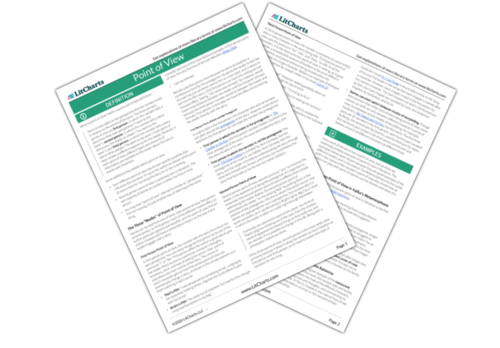
- PDFs for all 136 Lit Terms we cover
- Downloads of 1944 LitCharts Lit Guides
- Teacher Editions for every Lit Guide
- Explanations and citation info for 40,985 quotes across 1944 books
- Downloadable (PDF) line-by-line translations of every Shakespeare play
- Protagonist
- Anadiplosis
- Figurative Language
- Foreshadowing
- Dynamic Character
- Rising Action
- Tragic Hero
- Antimetabole


Want to create or adapt books like this? Learn more about how Pressbooks supports open publishing practices.
9.1 Developing a Strong, Clear Thesis Statement
Learning objectives.
- Develop a strong, clear thesis statement with the proper elements.
- Revise your thesis statement.
Have you ever known a person who was not very good at telling stories? You probably had trouble following his train of thought as he jumped around from point to point, either being too brief in places that needed further explanation or providing too many details on a meaningless element. Maybe he told the end of the story first, then moved to the beginning and later added details to the middle. His ideas were probably scattered, and the story did not flow very well. When the story was over, you probably had many questions.
Just as a personal anecdote can be a disorganized mess, an essay can fall into the same trap of being out of order and confusing. That is why writers need a thesis statement to provide a specific focus for their essay and to organize what they are about to discuss in the body.
Just like a topic sentence summarizes a single paragraph, the thesis statement summarizes an entire essay. It tells the reader the point you want to make in your essay, while the essay itself supports that point. It is like a signpost that signals the essay’s destination. You should form your thesis before you begin to organize an essay, but you may find that it needs revision as the essay develops.
Elements of a Thesis Statement
For every essay you write, you must focus on a central idea. This idea stems from a topic you have chosen or been assigned or from a question your teacher has asked. It is not enough merely to discuss a general topic or simply answer a question with a yes or no. You have to form a specific opinion, and then articulate that into a controlling idea —the main idea upon which you build your thesis.
Remember that a thesis is not the topic itself, but rather your interpretation of the question or subject. For whatever topic your professor gives you, you must ask yourself, “What do I want to say about it?” Asking and then answering this question is vital to forming a thesis that is precise, forceful and confident.
A thesis is one sentence long and appears toward the end of your introduction. It is specific and focuses on one to three points of a single idea—points that are able to be demonstrated in the body. It forecasts the content of the essay and suggests how you will organize your information. Remember that a thesis statement does not summarize an issue but rather dissects it.
A Strong Thesis Statement
A strong thesis statement contains the following qualities.
Specificity. A thesis statement must concentrate on a specific area of a general topic. As you may recall, the creation of a thesis statement begins when you choose a broad subject and then narrow down its parts until you pinpoint a specific aspect of that topic. For example, health care is a broad topic, but a proper thesis statement would focus on a specific area of that topic, such as options for individuals without health care coverage.
Precision. A strong thesis statement must be precise enough to allow for a coherent argument and to remain focused on the topic. If the specific topic is options for individuals without health care coverage, then your precise thesis statement must make an exact claim about it, such as that limited options exist for those who are uninsured by their employers. You must further pinpoint what you are going to discuss regarding these limited effects, such as whom they affect and what the cause is.
Ability to be argued. A thesis statement must present a relevant and specific argument. A factual statement often is not considered arguable. Be sure your thesis statement contains a point of view that can be supported with evidence.
Ability to be demonstrated. For any claim you make in your thesis, you must be able to provide reasons and examples for your opinion. You can rely on personal observations in order to do this, or you can consult outside sources to demonstrate that what you assert is valid. A worthy argument is backed by examples and details.
Forcefulness. A thesis statement that is forceful shows readers that you are, in fact, making an argument. The tone is assertive and takes a stance that others might oppose.
Confidence. In addition to using force in your thesis statement, you must also use confidence in your claim. Phrases such as I feel or I believe actually weaken the readers’ sense of your confidence because these phrases imply that you are the only person who feels the way you do. In other words, your stance has insufficient backing. Taking an authoritative stance on the matter persuades your readers to have faith in your argument and open their minds to what you have to say.
Even in a personal essay that allows the use of first person, your thesis should not contain phrases such as in my opinion or I believe . These statements reduce your credibility and weaken your argument. Your opinion is more convincing when you use a firm attitude.
On a separate sheet of paper, write a thesis statement for each of the following topics. Remember to make each statement specific, precise, demonstrable, forceful and confident.
- Texting while driving
- The legal drinking age in the United States
- Steroid use among professional athletes
Examples of Appropriate Thesis Statements
Each of the following thesis statements meets several of the following requirements:
- Specificity
- Ability to be argued
- Ability to be demonstrated
- Forcefulness
- The societal and personal struggles of Troy Maxon in the play Fences symbolize the challenge of black males who lived through segregation and integration in the United States.
- Closing all American borders for a period of five years is one solution that will tackle illegal immigration.
- Shakespeare’s use of dramatic irony in Romeo and Juliet spoils the outcome for the audience and weakens the plot.
- J. D. Salinger’s character in Catcher in the Rye , Holden Caulfield, is a confused rebel who voices his disgust with phonies, yet in an effort to protect himself, he acts like a phony on many occasions.
- Compared to an absolute divorce, no-fault divorce is less expensive, promotes fairer settlements, and reflects a more realistic view of the causes for marital breakdown.
- Exposing children from an early age to the dangers of drug abuse is a sure method of preventing future drug addicts.
- In today’s crumbling job market, a high school diploma is not significant enough education to land a stable, lucrative job.
You can find thesis statements in many places, such as in the news; in the opinions of friends, coworkers or teachers; and even in songs you hear on the radio. Become aware of thesis statements in everyday life by paying attention to people’s opinions and their reasons for those opinions. Pay attention to your own everyday thesis statements as well, as these can become material for future essays.
Now that you have read about the contents of a good thesis statement and have seen examples, take a look at the pitfalls to avoid when composing your own thesis:
A thesis is weak when it is simply a declaration of your subject or a description of what you will discuss in your essay.
Weak thesis statement: My paper will explain why imagination is more important than knowledge.
A thesis is weak when it makes an unreasonable or outrageous claim or insults the opposing side.
Weak thesis statement: Religious radicals across America are trying to legislate their Puritanical beliefs by banning required high school books.
A thesis is weak when it contains an obvious fact or something that no one can disagree with or provides a dead end.
Weak thesis statement: Advertising companies use sex to sell their products.
A thesis is weak when the statement is too broad.
Weak thesis statement: The life of Abraham Lincoln was long and challenging.
Read the following thesis statements. On a separate piece of paper, identify each as weak or strong. For those that are weak, list the reasons why. Then revise the weak statements so that they conform to the requirements of a strong thesis.
- The subject of this paper is my experience with ferrets as pets.
- The government must expand its funding for research on renewable energy resources in order to prepare for the impending end of oil.
- Edgar Allan Poe was a poet who lived in Baltimore during the nineteenth century.
- In this essay, I will give you lots of reasons why slot machines should not be legalized in Baltimore.
- Despite his promises during his campaign, President Kennedy took few executive measures to support civil rights legislation.
- Because many children’s toys have potential safety hazards that could lead to injury, it is clear that not all children’s toys are safe.
- My experience with young children has taught me that I want to be a disciplinary parent because I believe that a child without discipline can be a parent’s worst nightmare.
Writing at Work
Often in your career, you will need to ask your boss for something through an e-mail. Just as a thesis statement organizes an essay, it can also organize your e-mail request. While your e-mail will be shorter than an essay, using a thesis statement in your first paragraph quickly lets your boss know what you are asking for, why it is necessary, and what the benefits are. In short body paragraphs, you can provide the essential information needed to expand upon your request.
Thesis Statement Revision
Your thesis will probably change as you write, so you will need to modify it to reflect exactly what you have discussed in your essay. Remember from Chapter 8 “The Writing Process: How Do I Begin?” that your thesis statement begins as a working thesis statement , an indefinite statement that you make about your topic early in the writing process for the purpose of planning and guiding your writing.
Working thesis statements often become stronger as you gather information and form new opinions and reasons for those opinions. Revision helps you strengthen your thesis so that it matches what you have expressed in the body of the paper.
The best way to revise your thesis statement is to ask questions about it and then examine the answers to those questions. By challenging your own ideas and forming definite reasons for those ideas, you grow closer to a more precise point of view, which you can then incorporate into your thesis statement.
Ways to Revise Your Thesis
You can cut down on irrelevant aspects and revise your thesis by taking the following steps:
1. Pinpoint and replace all nonspecific words, such as people , everything , society , or life , with more precise words in order to reduce any vagueness.
Working thesis: Young people have to work hard to succeed in life.
Revised thesis: Recent college graduates must have discipline and persistence in order to find and maintain a stable job in which they can use and be appreciated for their talents.
The revised thesis makes a more specific statement about success and what it means to work hard. The original includes too broad a range of people and does not define exactly what success entails. By replacing those general words like people and work hard , the writer can better focus his or her research and gain more direction in his or her writing.
2. Clarify ideas that need explanation by asking yourself questions that narrow your thesis.
Working thesis: The welfare system is a joke.
Revised thesis: The welfare system keeps a socioeconomic class from gaining employment by alluring members of that class with unearned income, instead of programs to improve their education and skill sets.
A joke means many things to many people. Readers bring all sorts of backgrounds and perspectives to the reading process and would need clarification for a word so vague. This expression may also be too informal for the selected audience. By asking questions, the writer can devise a more precise and appropriate explanation for joke . The writer should ask himself or herself questions similar to the 5WH questions. (See Chapter 8 “The Writing Process: How Do I Begin?” for more information on the 5WH questions.) By incorporating the answers to these questions into a thesis statement, the writer more accurately defines his or her stance, which will better guide the writing of the essay.
3. Replace any linking verbs with action verbs. Linking verbs are forms of the verb to be , a verb that simply states that a situation exists.
Working thesis: Kansas City schoolteachers are not paid enough.
Revised thesis: The Kansas City legislature cannot afford to pay its educators, resulting in job cuts and resignations in a district that sorely needs highly qualified and dedicated teachers.
The linking verb in this working thesis statement is the word are . Linking verbs often make thesis statements weak because they do not express action. Rather, they connect words and phrases to the second half of the sentence. Readers might wonder, “Why are they not paid enough?” But this statement does not compel them to ask many more questions. The writer should ask himself or herself questions in order to replace the linking verb with an action verb, thus forming a stronger thesis statement, one that takes a more definitive stance on the issue:
- Who is not paying the teachers enough?
- What is considered “enough”?
- What is the problem?
- What are the results
4. Omit any general claims that are hard to support.
Working thesis: Today’s teenage girls are too sexualized.
Revised thesis: Teenage girls who are captivated by the sexual images on MTV are conditioned to believe that a woman’s worth depends on her sensuality, a feeling that harms their self-esteem and behavior.
It is true that some young women in today’s society are more sexualized than in the past, but that is not true for all girls. Many girls have strict parents, dress appropriately, and do not engage in sexual activity while in middle school and high school. The writer of this thesis should ask the following questions:
- Which teenage girls?
- What constitutes “too” sexualized?
- Why are they behaving that way?
- Where does this behavior show up?
- What are the repercussions?
In the first section of Chapter 8 “The Writing Process: How Do I Begin?” , you determined your purpose for writing and your audience. You then completed a freewriting exercise about an event you recently experienced and chose a general topic to write about. Using that general topic, you then narrowed it down by answering the 5WH questions. After you answered these questions, you chose one of the three methods of prewriting and gathered possible supporting points for your working thesis statement.
Now, on a separate sheet of paper, write down your working thesis statement. Identify any weaknesses in this sentence and revise the statement to reflect the elements of a strong thesis statement. Make sure it is specific, precise, arguable, demonstrable, forceful, and confident.
Collaboration
Please share with a classmate and compare your answers.
In your career you may have to write a project proposal that focuses on a particular problem in your company, such as reinforcing the tardiness policy. The proposal would aim to fix the problem; using a thesis statement would clearly state the boundaries of the problem and tell the goals of the project. After writing the proposal, you may find that the thesis needs revision to reflect exactly what is expressed in the body. Using the techniques from this chapter would apply to revising that thesis.
Key Takeaways
- Proper essays require a thesis statement to provide a specific focus and suggest how the essay will be organized.
- A thesis statement is your interpretation of the subject, not the topic itself.
- A strong thesis is specific, precise, forceful, confident, and is able to be demonstrated.
- A strong thesis challenges readers with a point of view that can be debated and can be supported with evidence.
- A weak thesis is simply a declaration of your topic or contains an obvious fact that cannot be argued.
- Depending on your topic, it may or may not be appropriate to use first person point of view.
- Revise your thesis by ensuring all words are specific, all ideas are exact, and all verbs express action.
Writing for Success Copyright © 2015 by University of Minnesota is licensed under a Creative Commons Attribution-NonCommercial-ShareAlike 4.0 International License , except where otherwise noted.

Reading Skills
Analyzing author’s purpose and point of view.
- The Albert Team
- Last Updated On: June 16, 2023
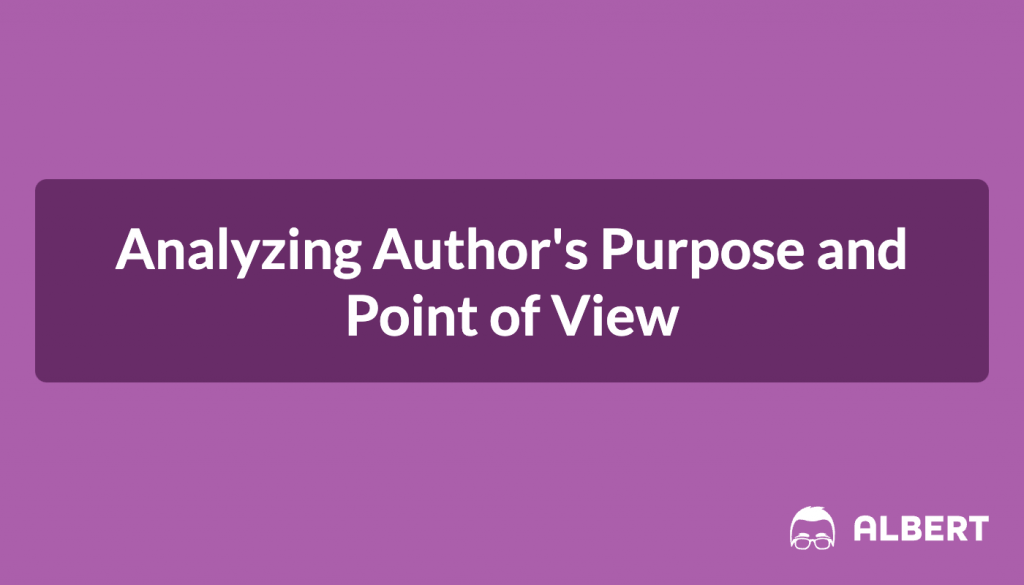
Introduction
Do you ever wonder why writers write the way they do? Why they pick certain words or tell a story in a specific way? The reason behind this is called the author’s purpose and point of view. It’s like a secret code that helps you understand what they really mean.
In this blog post, we’ll learn about this secret code. You’ll learn to figure out what an author is trying to say, and how they see the world. This will help you understand books, articles, and even posts on social media even better!

What is the Author’s Point of View?
When you read a text, it’s important to think about the author’s point of view. The author’s point of view refers to their unique perspective, opinions, beliefs, and biases that shape how they present information or tell a story. They might see things in a way that’s different from you because of their own experiences, beliefs, and backgrounds.
Understanding an author’s point of view allows us to dig deeper into the underlying motivations and intentions behind their words. It can also help you find hidden messages in the text. So, how do we figure out an author’s point of view? Let’s talk about some ways to do this.

How to Determine the Author’s Point of View
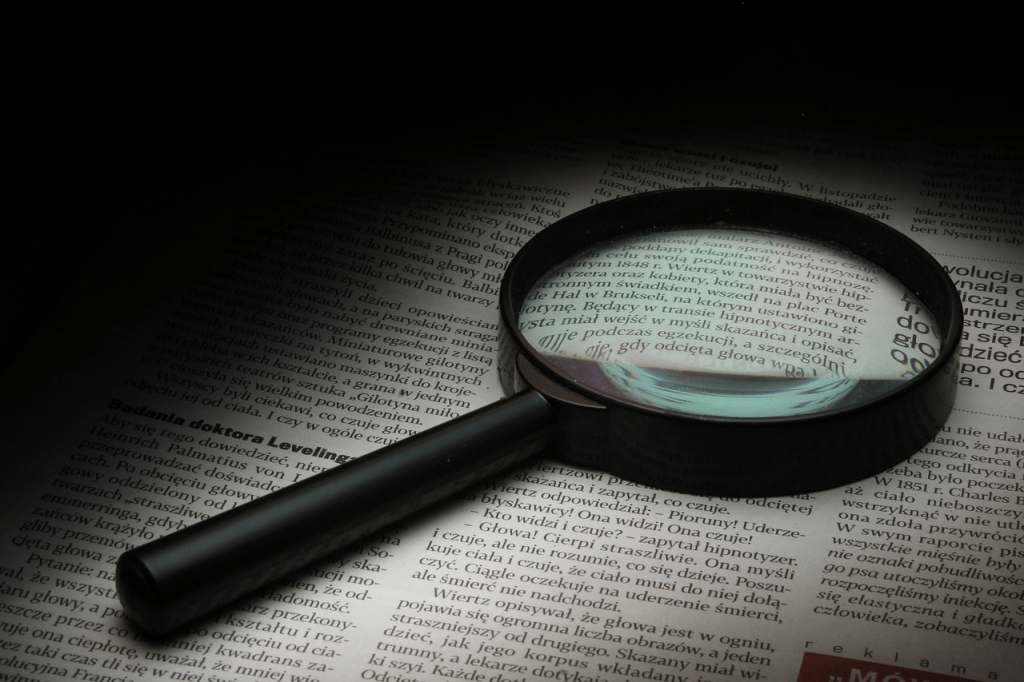
You might think figuring out an author’s point of view is hard, but it can be fun, like solving a mystery! Here are some tips to help you do it:
- Look at the Words : Notice the words the author uses. Are they showing strong feelings or opinions? The way they write can give you hints about what they think and feel.
- Learn About the Author : Knowing more about the author can help you understand their point of view. What kind of job do they have? Where are they from? What are some important things that have happened to them?
- Think About Why the Author Wrote the Text: Why do you think the author wrote this? Do they want to teach you something, make you think, or make you laugh? Knowing this can help you understand what they’re trying to say.
- Notice Patterns: Look for ideas that come up again and again. These can tell you a lot about what the author thinks is important.
- Think About Who the Author is Writing For: Authors often write for specific groups of people. The way they write can tell you a lot about who they are trying to talk to.
Remember, figuring out an author’s point of view is about understanding the text better, not about deciding if they are right or wrong.
Why is the Author’s Point of View Important?

Why should we care about the author’s point of view? Here are some good reasons:
- Contextual Understanding : The author’s point of view helps us make sense of the text. It shows us why they chose to write the way they did and what they want us to learn.
- Uncovering Bias: No author can be totally unbiased. By understanding their point of view, we can see their own opinions in the text. This helps us think critically about what we’re reading.
- Evaluating Objectivity: Knowing the author’s point of view helps us see if the text is objective (without personal feelings) or subjective (based on personal feelings). This can help us decide if we can trust the information in the text.
- Enhancing Interpretation: Understanding the author’s point of view helps us understand what the text really means. We can see what arguments the author is making and think more deeply about the text.
- Encouraging Empathy and Perspective: By seeing things from the author’s point of view, we can better understand people who are different from us. This helps us be more understanding and open-minded.
As you can see, knowing the author’s point of view helps us understand and think about what we read in a deeper way. It makes us better readers and thinkers!
How to Determine the Author’s Purpose

In addition to analyzing the author’s point of view, it is also key to examine the author’s purpose. Here are some tips to help you figure out the author’s purpose:
- Check the Type of Text: Look at what kind of text it is. Is it a story, a news article, or maybe an essay? This can give you clues about why the author wrote it.
- Look at the Words and Tone: Pay attention to the words the author uses and how they write. If they use a lot of emotion, they might be trying to persuade you. If they give a lot of facts, they’re probably trying to inform you.
- Think About Who It’s Written For: Who is the author writing for? For example, a text for experts might be trying to give new information, while a text for kids might be trying to teach something in a fun way.
- Look for Main Ideas: What are the big ideas in the text? What is the author trying to say? This can give you a hint about why they wrote it.
- Check for Facts or Stories: Does the author use a lot of facts and data? Or do they tell stories? This can also help you figure out the author’s purpose.
- Think About the Time and Place: When and where was the text written? Sometimes, this can tell you a lot about why the author wrote the text.
Remember, you might not always see the author’s purpose right away. But if you look closely, you can usually find clues that will help you figure it out.
How Text Structure Contributes to the Author’s Purpose

Text structure, or the way a text is put together, plays a significant role in conveying the author’s purpose and shaping the overall message of a written piece. The way a text is organized and structured can greatly influence how the information is presented and how the reader engages with it. Here are some ways that text structure contributes to the author’s purpose
- Order of Ideas: Authors choose how to order their ideas for a reason. They might use a time order, cause and effect, or compare and contrast to help get their point across.
- Important Points Stand Out: Authors use things like headings or bullet points to show important ideas. This can tell us what the author thinks is most important.
- Storytelling Techniques: In stories, authors might play with the order of events, use flashbacks, or tell the story from different viewpoints. This can make the story more interesting or help make a point.
- Persuasion Techniques: If the author is trying to convince you of something, they will present their arguments in a careful order. They might present a problem, then give evidence, then propose a solution.
- Easy to Follow: A well-organized text is easier to understand. The way the author organizes the text can help you follow their ideas and understand what they want to say.
By looking at how a text is structured, you can get a better idea of what the author’s purpose is. So, next time you read something, pay attention to how it’s put together!
Classroom Application: What is the Author’s Purpose in this Passage?

Analyzing the author’s purpose becomes more engaging and relatable when you can apply your skills to historical speeches. One exemplary text for this exercise is Abraham Lincoln’s Second Inaugural Address. Use this step-by-step guide to analyze the author’s purpose in this significant piece of writing:
Step 1: Background Research:
First, start by gathering some background information about Abraham Lincoln, his presidency, and the context of the Second Inaugural Address. Learn about the Civil War and how it impacted the nation during that time.
Step 2: Reading and Annotation:
Next, read the Second Inaugural Address carefully, highlighting or underlining key statements and phrases. Take note of any repeated themes or arguments and mark moments where Lincoln’s perspective or tone seems particularly important.
Step 3: Identifying the Type of Text:
Consider the type of text you are analyzing, which is a presidential inauguration speech. Think about the common purposes associated with such speeches, like inspiring unity, expressing gratitude, or outlining a vision for the nation.
Step 4: Analyzing Language and Tone:
Pay close attention to Lincoln’s choice of language and tone throughout the address. Look for emotional or persuasive language and note instances of unity, humility, or calls for reconciliation. Consider how these choices contribute to Lincoln’s purpose.
Step 5: Reflecting on Historical Context:
Think about the historical context surrounding the Second Inaugural Address. For example, you could reflect on the divided nation during the Civil War and how it affected Lincoln’s presidency. Then, connect these historical events to Lincoln’s purpose in addressing the nation during such a critical time.
Step 6: Identifying Key Statements and Arguments:
Identify the central statements and arguments made by Lincoln in the address. Consider how these statements reflect his purpose and the message he wanted to convey. Think critically about the implications of these arguments.
Step 7: Considering the Audience:
Reflect on the intended audience of the Second Inaugural Address, which includes both supporters and opponents of Lincoln. Analyze how Lincoln’s purpose might have been influenced by this diverse audience and how he aimed to unite the nation through his words.
Step 8: Drawing Conclusions:
Based on the evidence you gathered from the text analysis and understanding of the historical context, draw conclusions about Lincoln’s purpose in delivering the Second Inaugural Address. Make sure to support your conclusions with evidence from the text.
Step 9: Classroom Discussion and Reflection:
Finally, wrap up by participating in a classroom discussion, where you can share your analysis and engage in thoughtful reflection. Compare and contrast interpretations with your classmates to deepen your understanding of the author’s purpose and the complexities of historical texts.
By following these steps to analyze Lincoln’s Second Inaugural Address, you’ll develop critical thinking skills, gain historical understanding, and appreciate the power of language in shaping significant historical events. This assignment will enhance your ability to analyze texts and provide you with a deeper insight into the intentions of historical figures like Abraham Lincoln.
Analyzing an author’s purpose and point of view is a skill that empowers you to unlock the hidden meanings within texts. By understanding why authors write the way they do and recognizing their unique perspectives, you can gain valuable insights into the world of written communication.
Practice Makes Perfect
Albert provides engaging practice questions for key skills like analyzing the author’s purpose as well as a wide range of texts for students to analyze and interpret. For more practice with the skills covered in this post, check out our Author’s Purpose questions in our Short Readings course, which uses short passages to reinforce fundamental reading skills. Readers at all ability levels may enjoy our Leveled Readings course, which offers Lexile® leveled passages focused on a unifying essential question that keeps all students on the same page regardless of reading level. Learn more about the Lexile Framework here !
With our easy-to-use interface and informative feedback, Albert.io is the perfect tool for learning how to determine the author’s purpose and point of view and helping students develop a deeper understanding of the texts they encounter.
Interested in a school license?
Popular posts.

AP® Score Calculators
Simulate how different MCQ and FRQ scores translate into AP® scores

AP® Review Guides
The ultimate review guides for AP® subjects to help you plan and structure your prep.

Core Subject Review Guides
Review the most important topics in Physics and Algebra 1 .

SAT® Score Calculator
See how scores on each section impacts your overall SAT® score

ACT® Score Calculator
See how scores on each section impacts your overall ACT® score

Grammar Review Hub
Comprehensive review of grammar skills

AP® Posters
Download updated posters summarizing the main topics and structure for each AP® exam.
Point of View
Definition of point of view.
In the lives of children, pumpkins turn into coaches, mice and rats turn into men. When we grow up, we realize it is far more common for men to turn into rats.
Examples of Commonly Used Points of View
Here are some examples of commonly used points of view:
First Person
Third person.
With third person point of view, there is a narrative presence telling the story and referring to the characters in the third person, as “he” or “she.” Third person point of view can be omniscient , meaning the narrator can see and know everything within the story, or limited, meaning the narrator is restricted in what they see and know of the story.
Second Person
Difference between omniscient and third person limited point of view, writing with point of view.
Writers decide who tells a story and the intended audience for it. When determining point of view as a literary device, the story can be told from the viewpoint of a character who is part of the story or from a narrative perspective that “sees” and knows the characters but is not one of them. It’s important for writers to consider benefits and limitations when deciding point of view, as it is essential for character development and the relationship between the narrative voice and the reader.
Alternating Point of View
First person point of view as a protagonist and common character, use of point of view in sentences, examples of point of view in literature, example 1: invisible man (ralph ellison).
I was never more hated than when I tried to be honest. Or when, even as just now I’ve tried to articulate exactly what I felt to be the truth. No one was satisfied.
Example 2: The Story of an Hour (Kate Chopin)
She said it over and over under her breath: “free, free, free!” The vacant stare and the look of terror that had followed it went from her eyes. They stayed keen and bright. Her pulses beat fast, and the coursing blood warmed and relaxed every inch of her body.
Example 3: The Death of Ivan Ilych (Leo Tolstoy)
In reality it was just what is usually seen in the houses of people of moderate means who want to appear rich, and therefore succeed only in resembling others like themselves: there are damasks, dark wood, plants, rugs, and dull and polished bronzes — all the things people of a certain class have in order to resemble other people of that class. His house was so like the others that it would never have been noticed, but to him it all seemed to be quite exceptional.
Synonyms of Point of View
Post navigation.
- Literary Terms
- Point of View
- Definition & Examples
- When & How to Use Point of View
I. What is Point of View?
Point of view (POV) is what the character or narrator telling the story can see (his or her perspective). The author chooses “who” is to tell the story by determining the point of view. Depending on who the narrator is, he/she will be standing at one point and seeing the action. This viewpoint will give the narrator a partial or whole view of events as they happen. Many stories have the protagonist telling the story, while in others, the narrator may be another character or an outside viewer, a narrator who is not in the story at all. The narrator should not be confused with the author, who is the writer of the story and whose opinions may not be those written into the narrative.
II. Examples of Point of View
Sandra Cisneros wrote a story called “Eleven.” The point of view is the perspective of 11-year-old Rachel. The story takes place at school during her birthday and is about her humiliation of receiving an old sweater. Throughout the story, she speaks in the first-person point of view, sharing her thoughts as events unfold.
“Only today I wish I didn’t have only eleven years rattling inside me like pennies in a tin Band-Aid box. Today I wish I was one hundred and two instead of eleven because if I was one hundred and two I’d have known what to say when Mrs. Price put the red sweater on my desk” (Cisneros).
A fun activity is to rewrite the story from each character’s point of view. What is the teacher thinking as she tries to get rid of this ugly red sweater in her classroom? Maybe it reminds her of her demanding mother! How does the sweater feel being tossed and pushed around, unwanted and unloved? Maybe some sweet old lady had knitted it with love for a granddaughter who now has rejected it. Why does Sylvia say it belongs to Rachel? Is she jealous of Rachel for some reason? Each character will have a slightly different story from his or her perspective.
III. Types of Point of View
First person: The example above with little Rachel is told in the first-person point of view, meaning that we are seeing events through the eyes of the character telling the story.
Second person: In second person, the narrator is speaking to YOU. This isn’t very common in fiction, unless the narrator is trying to talk to the reader personally. We see second-person point of view mostly in poems, speeches, instructional writing, and persuasive articles.
Third person: With third-person point of view, the narrator is describing what’s seen, but as a spectator. If the narrator is a character in the story, then we are reading what he or she observes as the story unfolds. This narrator has three possible perspectives.
- Limited – In limited third-person, the narrator sees only what’s in front of him/her, a spectator of events as they unfold and unable to read any other character’s mind.
- Omniscient – An omniscient narrator sees all, much as an all knowing god of some kind. He or she sees what each character is doing and can see into each character’s mind. This is common with an external character, who is standing above, watching the action below (think of a person with a crystal ball, peering in).
- Limited Omniscient – The limited omniscient third-person narrator can only see into one character’s mind. He/she might see other events happening, but only knows the reasons of one character’s actions in the story.
IV. The Importance of Point of View
Point of view is important in a story because it helps the reader understand characters’ feelings and actions. Each character will have his or her own perspective, so whoever is telling the story will impact the reader’s opinion of other characters and events.
As in the example above with Rachel and the red sweater, each point of view could be an entirely different story. Perhaps Rachel had embarrassed Sylvia horribly one day, so the sympathy we feel for Rachel in her perspective may change to sympathy for Sylvia if the point of view was switched.
Additionally, reading the story from a character in the story versus an external character changes the amount of information a reader has as the story unfolds. With an omniscient third-person, we can see everything before other characters do, which gives us forewarning about other events. With a limited third-person, we are not allowed to see other events until the narrator does so. This may leave us with more surprises as we read.
V. Examples of Point of View in Pop Culture
A very popular (and very old!) game is Mario Brothers. A gamer took the game and made a video of it in first-person point of view. It’s almost a dizzying experience to see Mario catch coins and jump around from his viewpoint.

Arcades have had games with a first-person POV for years. You sit in the console to drive the car in a race, or use the pistol and fire at targets. Racing games are probably the easiest to play as a first-person. With most games, you control the character in a game, but almost from a second-person POV. You can see your character as you control it within the game space just as another character would.
VI. Examples of Point of View in Literature
“Diary of a Wimpy Kid” by Jeff Kinney has been cracking kids up since 2007, as the protagonist, Greg Heffley, details his experiences in his trusty journal; he claims it’s NOT a diary. He even supplies stick drawings with bubble speech to illustrate special, usually devastating or hilarious, occurrences. Written in the first-person POV, we follow him through his days with his friends and family. Greg’s dry sense of reality as he tells his sad tales leaves us giggling sympathetically – you can’t help but feel sorry for him, and many kids can relate to his frustrations. There are nine books as of 2015, each one focusing on specific conflicts Greg must overcome as he makes his way through middle school and attempts to fit in with his family.
“First of all, let me get something straight: This is a Journal, not a diary. I know what it says on the cover, but when Mom went out to buy this thing I specifically told her to get one that didn’t say “diary” on it. Great. All I need is for some jerk to catch me carrying this book around and get the wrong idea” (Kinney 1). http://www.funbrain.com/journal/Journal.html?ThisJournalDay=1&ThisPage=2
The book is so popular, that it was also made into a movie.

VII. Related Terms
Narrator: The narrator is the person who tells the story. There are different types of narrators, such as internal and external. Each narrator will have his or her own perspective or point of view as the story is told.
Viewpoint: Viewpoint is the perspective at which something is seen. If three people see an accident, each person will have his or her own version of what happened depending on where the person was at the time it happened.
VIII. Conclusion
Point of view is an important part of all writing. It makes stories interesting, gives research its serious tone, poems and persuasive works their personal tone, and allows readers to easily follow all writing. Keeping in mind the different types of POV and when to use them will make your writing stronger.
List of Terms
- Alliteration
- Amplification
- Anachronism
- Anthropomorphism
- Antonomasia
- APA Citation
- Aposiopesis
- Autobiography
- Bildungsroman
- Characterization
- Circumlocution
- Cliffhanger
- Comic Relief
- Connotation
- Deus ex machina
- Deuteragonist
- Doppelganger
- Double Entendre
- Dramatic irony
- Equivocation
- Extended Metaphor
- Figures of Speech
- Flash-forward
- Foreshadowing
- Intertextuality
- Juxtaposition
- Literary Device
- Malapropism
- Onomatopoeia
- Parallelism
- Pathetic Fallacy
- Personification
- Polysyndeton
- Protagonist
- Red Herring
- Rhetorical Device
- Rhetorical Question
- Science Fiction
- Self-Fulfilling Prophecy
- Synesthesia
- Turning Point
- Understatement
- Urban Legend
- Verisimilitude
- Essay Guide
- Cite This Website
- Resources Home 🏠
- Try SciSpace Copilot
- Search research papers
- Add Copilot Extension
- Try AI Detector
- Try Paraphraser
- Try Citation Generator
- April Papers
- June Papers
- July Papers

What is a thesis | A Complete Guide with Examples

Table of Contents
A thesis is a comprehensive academic paper based on your original research that presents new findings, arguments, and ideas of your study. It’s typically submitted at the end of your master’s degree or as a capstone of your bachelor’s degree.
However, writing a thesis can be laborious, especially for beginners. From the initial challenge of pinpointing a compelling research topic to organizing and presenting findings, the process is filled with potential pitfalls.
Therefore, to help you, this guide talks about what is a thesis. Additionally, it offers revelations and methodologies to transform it from an overwhelming task to a manageable and rewarding academic milestone.
What is a thesis?
A thesis is an in-depth research study that identifies a particular topic of inquiry and presents a clear argument or perspective about that topic using evidence and logic.
Writing a thesis showcases your ability of critical thinking, gathering evidence, and making a compelling argument. Integral to these competencies is thorough research, which not only fortifies your propositions but also confers credibility to your entire study.
Furthermore, there's another phenomenon you might often confuse with the thesis: the ' working thesis .' However, they aren't similar and shouldn't be used interchangeably.
A working thesis, often referred to as a preliminary or tentative thesis, is an initial version of your thesis statement. It serves as a draft or a starting point that guides your research in its early stages.
As you research more and gather more evidence, your initial thesis (aka working thesis) might change. It's like a starting point that can be adjusted as you learn more. It's normal for your main topic to change a few times before you finalize it.
While a thesis identifies and provides an overarching argument, the key to clearly communicating the central point of that argument lies in writing a strong thesis statement.
What is a thesis statement?
A strong thesis statement (aka thesis sentence) is a concise summary of the main argument or claim of the paper. It serves as a critical anchor in any academic work, succinctly encapsulating the primary argument or main idea of the entire paper.
Typically found within the introductory section, a strong thesis statement acts as a roadmap of your thesis, directing readers through your arguments and findings. By delineating the core focus of your investigation, it offers readers an immediate understanding of the context and the gravity of your study.
Furthermore, an effectively crafted thesis statement can set forth the boundaries of your research, helping readers anticipate the specific areas of inquiry you are addressing.
Different types of thesis statements
A good thesis statement is clear, specific, and arguable. Therefore, it is necessary for you to choose the right type of thesis statement for your academic papers.
Thesis statements can be classified based on their purpose and structure. Here are the primary types of thesis statements:
Argumentative (or Persuasive) thesis statement
Purpose : To convince the reader of a particular stance or point of view by presenting evidence and formulating a compelling argument.
Example : Reducing plastic use in daily life is essential for environmental health.
Analytical thesis statement
Purpose : To break down an idea or issue into its components and evaluate it.
Example : By examining the long-term effects, social implications, and economic impact of climate change, it becomes evident that immediate global action is necessary.
Expository (or Descriptive) thesis statement
Purpose : To explain a topic or subject to the reader.
Example : The Great Depression, spanning the 1930s, was a severe worldwide economic downturn triggered by a stock market crash, bank failures, and reduced consumer spending.
Cause and effect thesis statement
Purpose : To demonstrate a cause and its resulting effect.
Example : Overuse of smartphones can lead to impaired sleep patterns, reduced face-to-face social interactions, and increased levels of anxiety.
Compare and contrast thesis statement
Purpose : To highlight similarities and differences between two subjects.
Example : "While both novels '1984' and 'Brave New World' delve into dystopian futures, they differ in their portrayal of individual freedom, societal control, and the role of technology."
When you write a thesis statement , it's important to ensure clarity and precision, so the reader immediately understands the central focus of your work.
What is the difference between a thesis and a thesis statement?
While both terms are frequently used interchangeably, they have distinct meanings.
A thesis refers to the entire research document, encompassing all its chapters and sections. In contrast, a thesis statement is a brief assertion that encapsulates the central argument of the research.
Here’s an in-depth differentiation table of a thesis and a thesis statement.
Aspect | Thesis | Thesis Statement |
Definition | An extensive document presenting the author's research and findings, typically for a degree or professional qualification. | A concise sentence or two in an essay or research paper that outlines the main idea or argument. |
Position | It’s the entire document on its own. | Typically found at the end of the introduction of an essay, research paper, or thesis. |
Components | Introduction, methodology, results, conclusions, and bibliography or references. | Doesn't include any specific components |
Purpose | Provides detailed research, presents findings, and contributes to a field of study. | To guide the reader about the main point or argument of the paper or essay. |
Now, to craft a compelling thesis, it's crucial to adhere to a specific structure. Let’s break down these essential components that make up a thesis structure
15 components of a thesis structure
Navigating a thesis can be daunting. However, understanding its structure can make the process more manageable.
Here are the key components or different sections of a thesis structure:
Your thesis begins with the title page. It's not just a formality but the gateway to your research.

Here, you'll prominently display the necessary information about you (the author) and your institutional details.
- Title of your thesis
- Your full name
- Your department
- Your institution and degree program
- Your submission date
- Your Supervisor's name (in some cases)
- Your Department or faculty (in some cases)
- Your University's logo (in some cases)
- Your Student ID (in some cases)
In a concise manner, you'll have to summarize the critical aspects of your research in typically no more than 200-300 words.

This includes the problem statement, methodology, key findings, and conclusions. For many, the abstract will determine if they delve deeper into your work, so ensure it's clear and compelling.
Acknowledgments
Research is rarely a solitary endeavor. In the acknowledgments section, you have the chance to express gratitude to those who've supported your journey.

This might include advisors, peers, institutions, or even personal sources of inspiration and support. It's a personal touch, reflecting the humanity behind the academic rigor.
Table of contents
A roadmap for your readers, the table of contents lists the chapters, sections, and subsections of your thesis.

By providing page numbers, you allow readers to navigate your work easily, jumping to sections that pique their interest.
List of figures and tables
Research often involves data, and presenting this data visually can enhance understanding. This section provides an organized listing of all figures and tables in your thesis.

It's a visual index, ensuring that readers can quickly locate and reference your graphical data.
Introduction
Here's where you introduce your research topic, articulate the research question or objective, and outline the significance of your study.

- Present the research topic : Clearly articulate the central theme or subject of your research.
- Background information : Ground your research topic, providing any necessary context or background information your readers might need to understand the significance of your study.
- Define the scope : Clearly delineate the boundaries of your research, indicating what will and won't be covered.
- Literature review : Introduce any relevant existing research on your topic, situating your work within the broader academic conversation and highlighting where your research fits in.
- State the research Question(s) or objective(s) : Clearly articulate the primary questions or objectives your research aims to address.
- Outline the study's structure : Give a brief overview of how the subsequent sections of your work will unfold, guiding your readers through the journey ahead.
The introduction should captivate your readers, making them eager to delve deeper into your research journey.
Literature review section
Your study correlates with existing research. Therefore, in the literature review section, you'll engage in a dialogue with existing knowledge, highlighting relevant studies, theories, and findings.

It's here that you identify gaps in the current knowledge, positioning your research as a bridge to new insights.
To streamline this process, consider leveraging AI tools. For example, the SciSpace literature review tool enables you to efficiently explore and delve into research papers, simplifying your literature review journey.
Methodology
In the research methodology section, you’ll detail the tools, techniques, and processes you employed to gather and analyze data. This section will inform the readers about how you approached your research questions and ensures the reproducibility of your study.

Here's a breakdown of what it should encompass:
- Research Design : Describe the overall structure and approach of your research. Are you conducting a qualitative study with in-depth interviews? Or is it a quantitative study using statistical analysis? Perhaps it's a mixed-methods approach?
- Data Collection : Detail the methods you used to gather data. This could include surveys, experiments, observations, interviews, archival research, etc. Mention where you sourced your data, the duration of data collection, and any tools or instruments used.
- Sampling : If applicable, explain how you selected participants or data sources for your study. Discuss the size of your sample and the rationale behind choosing it.
- Data Analysis : Describe the techniques and tools you used to process and analyze the data. This could range from statistical tests in quantitative research to thematic analysis in qualitative research.
- Validity and Reliability : Address the steps you took to ensure the validity and reliability of your findings to ensure that your results are both accurate and consistent.
- Ethical Considerations : Highlight any ethical issues related to your research and the measures you took to address them, including — informed consent, confidentiality, and data storage and protection measures.
Moreover, different research questions necessitate different types of methodologies. For instance:
- Experimental methodology : Often used in sciences, this involves a controlled experiment to discern causality.
- Qualitative methodology : Employed when exploring patterns or phenomena without numerical data. Methods can include interviews, focus groups, or content analysis.
- Quantitative methodology : Concerned with measurable data and often involves statistical analysis. Surveys and structured observations are common tools here.
- Mixed methods : As the name implies, this combines both qualitative and quantitative methodologies.
The Methodology section isn’t just about detailing the methods but also justifying why they were chosen. The appropriateness of the methods in addressing your research question can significantly impact the credibility of your findings.
Results (or Findings)
This section presents the outcomes of your research. It's crucial to note that the nature of your results may vary; they could be quantitative, qualitative, or a mix of both.

Quantitative results often present statistical data, showcasing measurable outcomes, and they benefit from tables, graphs, and figures to depict these data points.
Qualitative results , on the other hand, might delve into patterns, themes, or narratives derived from non-numerical data, such as interviews or observations.
Regardless of the nature of your results, clarity is essential. This section is purely about presenting the data without offering interpretations — that comes later in the discussion.
In the discussion section, the raw data transforms into valuable insights.
Start by revisiting your research question and contrast it with the findings. How do your results expand, constrict, or challenge current academic conversations?
Dive into the intricacies of the data, guiding the reader through its implications. Detail potential limitations transparently, signaling your awareness of the research's boundaries. This is where your academic voice should be resonant and confident.
Practical implications (Recommendation) section
Based on the insights derived from your research, this section provides actionable suggestions or proposed solutions.
Whether aimed at industry professionals or the general public, recommendations translate your academic findings into potential real-world actions. They help readers understand the practical implications of your work and how it can be applied to effect change or improvement in a given field.
When crafting recommendations, it's essential to ensure they're feasible and rooted in the evidence provided by your research. They shouldn't merely be aspirational but should offer a clear path forward, grounded in your findings.
The conclusion provides closure to your research narrative.
It's not merely a recap but a synthesis of your main findings and their broader implications. Reconnect with the research questions or hypotheses posited at the beginning, offering clear answers based on your findings.

Reflect on the broader contributions of your study, considering its impact on the academic community and potential real-world applications.
Lastly, the conclusion should leave your readers with a clear understanding of the value and impact of your study.
References (or Bibliography)
Every theory you've expounded upon, every data point you've cited, and every methodological precedent you've followed finds its acknowledgment here.

In references, it's crucial to ensure meticulous consistency in formatting, mirroring the specific guidelines of the chosen citation style .
Proper referencing helps to avoid plagiarism , gives credit to original ideas, and allows readers to explore topics of interest. Moreover, it situates your work within the continuum of academic knowledge.
To properly cite the sources used in the study, you can rely on online citation generator tools to generate accurate citations!
Here’s more on how you can cite your sources.
Often, the depth of research produces a wealth of material that, while crucial, can make the core content of the thesis cumbersome. The appendix is where you mention extra information that supports your research but isn't central to the main text.

Whether it's raw datasets, detailed procedural methodologies, extended case studies, or any other ancillary material, the appendices ensure that these elements are archived for reference without breaking the main narrative's flow.
For thorough researchers and readers keen on meticulous details, the appendices provide a treasure trove of insights.
Glossary (optional)
In academics, specialized terminologies, and jargon are inevitable. However, not every reader is versed in every term.
The glossary, while optional, is a critical tool for accessibility. It's a bridge ensuring that even readers from outside the discipline can access, understand, and appreciate your work.

By defining complex terms and providing context, you're inviting a wider audience to engage with your research, enhancing its reach and impact.
Remember, while these components provide a structured framework, the essence of your thesis lies in the originality of your ideas, the rigor of your research, and the clarity of your presentation.
As you craft each section, keep your readers in mind, ensuring that your passion and dedication shine through every page.
Thesis examples
To further elucidate the concept of a thesis, here are illustrative examples from various fields:
Example 1 (History): Abolition, Africans, and Abstraction: the Influence of the ‘Noble Savage’ on British and French Antislavery Thought, 1787-1807 by Suchait Kahlon.
Example 2 (Climate Dynamics): Influence of external forcings on abrupt millennial-scale climate changes: a statistical modelling study by Takahito Mitsui · Michel Crucifix
Checklist for your thesis evaluation
Evaluating your thesis ensures that your research meets the standards of academia. Here's an elaborate checklist to guide you through this critical process.
Content and structure
- Is the thesis statement clear, concise, and debatable?
- Does the introduction provide sufficient background and context?
- Is the literature review comprehensive, relevant, and well-organized?
- Does the methodology section clearly describe and justify the research methods?
- Are the results/findings presented clearly and logically?
- Does the discussion interpret the results in light of the research question and existing literature?
- Is the conclusion summarizing the research and suggesting future directions or implications?
Clarity and coherence
- Is the writing clear and free of jargon?
- Are ideas and sections logically connected and flowing?
- Is there a clear narrative or argument throughout the thesis?
Research quality
- Is the research question significant and relevant?
- Are the research methods appropriate for the question?
- Is the sample size (if applicable) adequate?
- Are the data analysis techniques appropriate and correctly applied?
- Are potential biases or limitations addressed?
Originality and significance
- Does the thesis contribute new knowledge or insights to the field?
- Is the research grounded in existing literature while offering fresh perspectives?
Formatting and presentation
- Is the thesis formatted according to institutional guidelines?
- Are figures, tables, and charts clear, labeled, and referenced in the text?
- Is the bibliography or reference list complete and consistently formatted?
- Are appendices relevant and appropriately referenced in the main text?
Grammar and language
- Is the thesis free of grammatical and spelling errors?
- Is the language professional, consistent, and appropriate for an academic audience?
- Are quotations and paraphrased material correctly cited?
Feedback and revision
- Have you sought feedback from peers, advisors, or experts in the field?
- Have you addressed the feedback and made the necessary revisions?
Overall assessment
- Does the thesis as a whole feel cohesive and comprehensive?
- Would the thesis be understandable and valuable to someone in your field?
Ensure to use this checklist to leave no ground for doubt or missed information in your thesis.
After writing your thesis, the next step is to discuss and defend your findings verbally in front of a knowledgeable panel. You’ve to be well prepared as your professors may grade your presentation abilities.
Preparing your thesis defense
A thesis defense, also known as "defending the thesis," is the culmination of a scholar's research journey. It's the final frontier, where you’ll present their findings and face scrutiny from a panel of experts.
Typically, the defense involves a public presentation where you’ll have to outline your study, followed by a question-and-answer session with a committee of experts. This committee assesses the validity, originality, and significance of the research.
The defense serves as a rite of passage for scholars. It's an opportunity to showcase expertise, address criticisms, and refine arguments. A successful defense not only validates the research but also establishes your authority as a researcher in your field.
Here’s how you can effectively prepare for your thesis defense .
Now, having touched upon the process of defending a thesis, it's worth noting that scholarly work can take various forms, depending on academic and regional practices.
One such form, often paralleled with the thesis, is the 'dissertation.' But what differentiates the two?
Dissertation vs. Thesis
Often used interchangeably in casual discourse, they refer to distinct research projects undertaken at different levels of higher education.
To the uninitiated, understanding their meaning might be elusive. So, let's demystify these terms and delve into their core differences.
Here's a table differentiating between the two.
Aspect | Thesis | Dissertation |
Purpose | Often for a master's degree, showcasing a grasp of existing research | Primarily for a doctoral degree, contributing new knowledge to the field |
Length | 100 pages, focusing on a specific topic or question. | 400-500 pages, involving deep research and comprehensive findings |
Research Depth | Builds upon existing research | Involves original and groundbreaking research |
Advisor's Role | Guides the research process | Acts more as a consultant, allowing the student to take the lead |
Outcome | Demonstrates understanding of the subject | Proves capability to conduct independent and original research |
Wrapping up
From understanding the foundational concept of a thesis to navigating its various components, differentiating it from a dissertation, and recognizing the importance of proper citation — this guide covers it all.
As scholars and readers, understanding these nuances not only aids in academic pursuits but also fosters a deeper appreciation for the relentless quest for knowledge that drives academia.
It’s important to remember that every thesis is a testament to curiosity, dedication, and the indomitable spirit of discovery.
Good luck with your thesis writing!
Frequently Asked Questions
A thesis typically ranges between 40-80 pages, but its length can vary based on the research topic, institution guidelines, and level of study.
A PhD thesis usually spans 200-300 pages, though this can vary based on the discipline, complexity of the research, and institutional requirements.
To identify a thesis topic, consider current trends in your field, gaps in existing literature, personal interests, and discussions with advisors or mentors. Additionally, reviewing related journals and conference proceedings can provide insights into potential areas of exploration.
The conceptual framework is often situated in the literature review or theoretical framework section of a thesis. It helps set the stage by providing the context, defining key concepts, and explaining the relationships between variables.
A thesis statement should be concise, clear, and specific. It should state the main argument or point of your research. Start by pinpointing the central question or issue your research addresses, then condense that into a single statement, ensuring it reflects the essence of your paper.
You might also like

Boosting Citations: A Comparative Analysis of Graphical Abstract vs. Video Abstract

The Impact of Visual Abstracts on Boosting Citations

Introducing SciSpace’s Citation Booster To Increase Research Visibility
Think of yourself as a member of a jury, listening to a lawyer who is presenting an opening argument. You'll want to know very soon whether the lawyer believes the accused to be guilty or not guilty, and how the lawyer plans to convince you. Readers of academic essays are like jury members: before they have read too far, they want to know what the essay argues as well as how the writer plans to make the argument. After reading your thesis statement, the reader should think, "This essay is going to try to convince me of something. I'm not convinced yet, but I'm interested to see how I might be."
An effective thesis cannot be answered with a simple "yes" or "no." A thesis is not a topic; nor is it a fact; nor is it an opinion. "Reasons for the fall of communism" is a topic. "Communism collapsed in Eastern Europe" is a fact known by educated people. "The fall of communism is the best thing that ever happened in Europe" is an opinion. (Superlatives like "the best" almost always lead to trouble. It's impossible to weigh every "thing" that ever happened in Europe. And what about the fall of Hitler? Couldn't that be "the best thing"?)
A good thesis has two parts. It should tell what you plan to argue, and it should "telegraph" how you plan to argue—that is, what particular support for your claim is going where in your essay.
Steps in Constructing a Thesis
First, analyze your primary sources. Look for tension, interest, ambiguity, controversy, and/or complication. Does the author contradict himself or herself? Is a point made and later reversed? What are the deeper implications of the author's argument? Figuring out the why to one or more of these questions, or to related questions, will put you on the path to developing a working thesis. (Without the why, you probably have only come up with an observation—that there are, for instance, many different metaphors in such-and-such a poem—which is not a thesis.)
Once you have a working thesis, write it down. There is nothing as frustrating as hitting on a great idea for a thesis, then forgetting it when you lose concentration. And by writing down your thesis you will be forced to think of it clearly, logically, and concisely. You probably will not be able to write out a final-draft version of your thesis the first time you try, but you'll get yourself on the right track by writing down what you have.
Keep your thesis prominent in your introduction. A good, standard place for your thesis statement is at the end of an introductory paragraph, especially in shorter (5-15 page) essays. Readers are used to finding theses there, so they automatically pay more attention when they read the last sentence of your introduction. Although this is not required in all academic essays, it is a good rule of thumb.
Anticipate the counterarguments. Once you have a working thesis, you should think about what might be said against it. This will help you to refine your thesis, and it will also make you think of the arguments that you'll need to refute later on in your essay. (Every argument has a counterargument. If yours doesn't, then it's not an argument—it may be a fact, or an opinion, but it is not an argument.)
This statement is on its way to being a thesis. However, it is too easy to imagine possible counterarguments. For example, a political observer might believe that Dukakis lost because he suffered from a "soft-on-crime" image. If you complicate your thesis by anticipating the counterargument, you'll strengthen your argument, as shown in the sentence below.
Some Caveats and Some Examples
A thesis is never a question. Readers of academic essays expect to have questions discussed, explored, or even answered. A question ("Why did communism collapse in Eastern Europe?") is not an argument, and without an argument, a thesis is dead in the water.
A thesis is never a list. "For political, economic, social and cultural reasons, communism collapsed in Eastern Europe" does a good job of "telegraphing" the reader what to expect in the essay—a section about political reasons, a section about economic reasons, a section about social reasons, and a section about cultural reasons. However, political, economic, social and cultural reasons are pretty much the only possible reasons why communism could collapse. This sentence lacks tension and doesn't advance an argument. Everyone knows that politics, economics, and culture are important.
A thesis should never be vague, combative or confrontational. An ineffective thesis would be, "Communism collapsed in Eastern Europe because communism is evil." This is hard to argue (evil from whose perspective? what does evil mean?) and it is likely to mark you as moralistic and judgmental rather than rational and thorough. It also may spark a defensive reaction from readers sympathetic to communism. If readers strongly disagree with you right off the bat, they may stop reading.
An effective thesis has a definable, arguable claim. "While cultural forces contributed to the collapse of communism in Eastern Europe, the disintegration of economies played the key role in driving its decline" is an effective thesis sentence that "telegraphs," so that the reader expects the essay to have a section about cultural forces and another about the disintegration of economies. This thesis makes a definite, arguable claim: that the disintegration of economies played a more important role than cultural forces in defeating communism in Eastern Europe. The reader would react to this statement by thinking, "Perhaps what the author says is true, but I am not convinced. I want to read further to see how the author argues this claim."
A thesis should be as clear and specific as possible. Avoid overused, general terms and abstractions. For example, "Communism collapsed in Eastern Europe because of the ruling elite's inability to address the economic concerns of the people" is more powerful than "Communism collapsed due to societal discontent."
Copyright 1999, Maxine Rodburg and The Tutors of the Writing Center at Harvard University

Choose Your Test
Sat / act prep online guides and tips, what is point of view first, second, and third person.
General Education

One of the best ways to prepare for the AP Literature exam is to learn about different literary devices and how you can use them to analyze everything from poetry to novels. Not only will this help you on the multiple choice section of the test, it’s critical for earning perfect scores on your essays, too!
Today, we’re going to take a closer look at one specific device: point of view. First, we’ll give you the point of view definition, then we’ll explain how the work’s narrator affects its point of view. Then we’ll explain the four types of point of view and provide examples and analysis for each one.
By the end of this article, you’ll be a point of view expert! So let’s get started.

Point of View: Definition and Meaning
In literature and poetry, point of view is defined as the perspective from which a story is told. Put another way, a story’s point of view is a way to articulate and analyze the position of the narrator in relation to the story they’re telling. Is the narrator a participant in the story they’re telling? Or are they describing events that happened to someone else? Both of these perspectives are different types of point of view (which we’ll talk about in a lot more depth later in this article, so hang tight)!
So how do you figure out the point of view in a text? In order to find the point of view of a story, you first have to identify whose perspective the story is told from. That’s because the perspective of the story determines a piece of literature’s point of view! That means that in order to establish a text’s point of view, you have to figure out the narrator of the text first.
What Is a Narrator?
Okay...so obviously figuring out the narrator of a piece of literature is important. But what’s a narrator, exactly? No matter what type of text you’re reading—whether it’s a newspaper article, a textbook, a poem, or a best-selling novel—someone is communicating the story to the reader. In literary terms, we call that someone the text’s narrator.
In other words, the narrator of a piece of literature is the person telling the story. And you know what’s even more helpful than that? Almost all written texts—whether they’re fiction, non-fiction, poetry, or otherwise—have a narrator.
And since a narrator and point of view go hand in hand, that means that almost all texts have a point of view, too!
Finding the Narrator
So how do you figure out the narrator of a text? Sometimes the narrator of a text is pretty easy to determine. For example, for a newspaper article, the narrator of the story is obviously the reporter who’s written the piece to report the facts. They’re the person who followed the story’s trail, and now they’re sharing the story with you!
Another good example of an “easy to find” comes from Herman Melville’s Moby Dick . The very first sentence of the book reads, “Call me Ishmael.” Because that’s a line in the text rather than a piece of dialogue that uses quotation marks, you know it’s the narrator speaking to the audience. In other words, the narrator of Moby Dick identifies himself and tells you his name in the very first line of the book!
But figuring out the narrator of the text isn’t always that easy. For example, the Harry Potter books by J.K Rowling don’t have an easily identifiable narrator. Neither do some classic works, like The Giver by Lois Lowry or Pride and Prejudice by Jane Austen . What do you do in those situations? Well, just hang tight: we’ll walk you through how point of view can help you figure out the narrator in these tricky situations !
Narrator vs. Point of View: What’s the Difference?
Before we start really digging into point of view, it’s worth pausing a minute to talk about the differences between point of view and narration. Because narration and point of view are closely linked, it’s tempting to think of them as interchangeable terms.
But the narrator of a text and the point of view of a text are two different things. The narrator is who is telling the story. In contrast, a text’s point of view is the perspective the story is being told from. If you think of the narrator as a person, their point of view is the angle they’re taking on the story.
Think of it this way: in literature, point of view and narrators go together like...well, like thunder and lightning. You can’t have one without the other, but they’re definitely not the same thing.
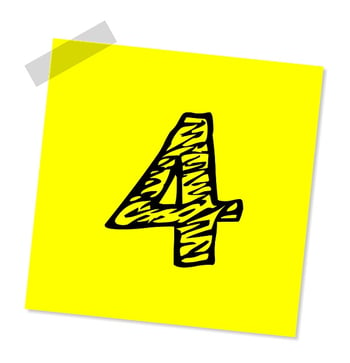
The 4 Types of Point of View
Okay, let’s look more closely at the four different types of point of view found in literature . In the following sections, we’ll explain each type of point of view, give you tips for figuring out if something is written in that perspective, and then walk you through a real-life example of that point of view in literature.

In first person point of view, you see the story through the narrator's eyes
First Person Point of View
In first person point of view, the story is told from the narrator’s perspective. This allows the narrator to give readers their first-hand experience, including what they saw, felt, thought, heard, said, and did. Think of it kind of like The Blair Witch Project : in first person point of view, it’s like the narrator is wearing a GoPro camera strapped to their forehead. The reader sees exactly what the narrator sees and gets their singular perspective on the events that unfold. In other words, a first person point of view makes the narrator the eyewitness to the plot of the story.
Using a first person point of view allows an author to dive much more deeply into the narrator’s character, since the reader gets to hear the narrator’s inner thoughts and experience the narrator’s emotions. Additionally, it makes the narrator the main character, or protagonist, of the story. If something is written in first person, it’s a pretty big indicator that the narrator is going to play a pivotal role in communicating the text’s messages or themes.
But there are also some pretty major limitations to a first person point of view, too. Just like real life, readers won’t be able to get the thoughts and feelings of other characters in the novel. Also, the narrator’s observations might be skewed depending on how they feel about other people. Because of that, first person narrators can be unreliable, meaning that their perspective skews the accuracy of the story they’re telling. That means it's up to the reader to determine whether they believe the narrator is being truthful or not.
Tips for Identifying First Person Point of View
In many ways, a first person point of view is one of the easiest to pick out because it uses first person pronoun s, like I, we, me, my, our, and us. If the book is written using these terms, then you can pretty much guarantee that the author is using first person!
Keep in mind that not all first person narrators are the book’s main character, l ike Moby Dick’s Ishmael or The Hunger Games’ Katniss Everdeen. That’s because first person narrators aren’t always the main characters in the work. Take, for instance, the Sherlock Holmes stories, where Dr. John Watson is the narrator. While he’s an important character in the story, he’s definitely not the main character--Sherlock Holmes is!
Additionally, sometimes first person narrators are anonymous, like third person narrators often are. (Don’t worry: we’ll get into third person narration in just a minute.) That’s why it’s best to look for pronouns when trying to figure out a work’s point of view! If you’re trying to find the narrator’s name, it might not always be there. A good example of this is Shakespeare’s “Sonnet 130,” where the narrator is describing the woman he loves. The narrator of the poem is never named, but because he uses pronouns like “I” and “my,” you know it’s written in first person.
Example of First Person Point of View: Shakespeare’s “Sonnet 29”
Many of Shakespeare’s sonnets are written in first person, and “Sonnet 29” is no different. Let’s look at the full poem and see why it qualifies as being written in first person:
I all alone beweep my outcast state, And trouble deaf heaven with my bootless cries, And look upon myself and curse my fate, Wishing me like to one more rich in hope, Featured like him, like him with friends possessed, Desiring this man’s art and that man’s scope, With what I most enjoy contented least; Yet in these thoughts myself almost despising, Haply I think on thee, and then my state, (Like to the lark at break of day arising From sullen earth) sings hymns at heaven’s gate; For thy sweet love remembered such wealth brings That then I scorn to change my state with kings.
Remember, we can tell that something’s written in first person if it uses first person pronouns outside of dialogue. Since there’s no dialogue in this poem at all, we can look at the entire text to find evidence of the first person point of view.
Notice that the narrator (or speaker, as the narrator is often referred to in poetry) uses words like “I,” “me,” and “myself” throughout the poem. This is a clear indicator that this poem is written in a first person point of view!
Actually, “Sonnet 29” is a good example of something written in first person where the narrator isn’t named. But we can still learn quite a bit about them through the poem itself! For example, we learn that he’s an outcast (line 2) who is unhappy with his current status (line 4). Despite his all-encompassing misery (line 9), when he thinks upon his love, his spirits are lifted (lines 10, 11, and 12). As we start piecing the evidence together, we begin to get a clearer picture of who the narrator of the poem is, and the power love has to lift us out of even the bleakest circumstance.
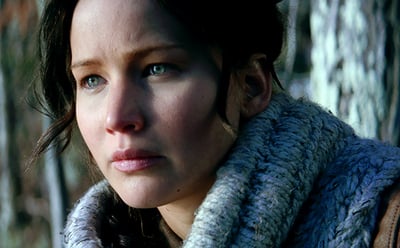
Other Works Written in First Person Point of View
First person is a really popular writing technique, so it’s no surprise that there are tons of books written in this point of view! Here are a few other poems, books, and book series that you might be familiar with that use first person point of view:
- Shakespeare’s “Sonnet 18”
- Suzanne Collins’ The Hunger Games book series
- Harper Lee’s To Kill a Mockingbird
- Arthur Conan Doyle’s Sherlock Holmes stories

Second person point of view uses pronouns like "you" and "your" to tell the story.
Second Person Point of View
In second person point of view, the story is told from the perspective of another character. Sometimes this character is another person in the book, but it can also be the reader themselves! More importantly, when a writer uses second person, they want readers to connect emotionally with the topic they’re writing about!
Here’s an example of what we mean. Say you’re reading an article about the amount of plastic pollution in the ocean. If the writer wants to pull on your heartstrings and make you take the issue they’re writing about seriously, they might use a second person point of view and write something like this:
“Imagine you’re on the vacation of your dreams sailing across the Caribbean. You can’t wait to get out into the open water, where everything will be calm, peaceful, and gorgeous. You take a nap as the captain sets sail, and when you return to the deck, you’re shocked by what you see. Instead of a vast expanse of sparkling blue water, you see a huge, bobbing mound of trash. Fast food containers, plastic bags, and discarded water bottles bob along the surface as far as you can see. It looks like you’re sailing through a garbage dump, and you feel equal parts disgust and despair.”
Using the second person point of view in a passage puts the reader into the story—in this case, it’s a story about pollution. Second person makes the reader feel like they’re making every move...from the joy of going on vacation, to the shock of seeing so much plastic in the water, to the “disgust and despair” of realizing what pollution is doing to the sea. Suddenly, the reader becomes more invested in what the author has to say about the problem, since the second person point of view makes them feel like they’ve experienced it first-hand!
While it’s very rare to find a text that’s written completely in second person, many authors will switch to this perspective when they want readers to feel connected to the topic they’re writing about.
Tips for Identifying Second Person Point of View
Like first person point of view, it’s pretty easy to spot the second person point of view...when you know what you’re looking for, that is. When something is written in second person, the writer uses second person pronouns (like “you,” “yourself,” and “your”) in the text that falls outside of dialogue , too.
Like we just mentioned, it’s pretty rare to find a whole text that’s written this way. More than likely, you’ll find a few paragraphs written in second person, rather than an entire work. The one exception to this rule is the classic Choose Your Own Adventure book ! You probably remember these from when you were a kid: each book had a topic, and at the bottom of each page, you were given decisions to make. Depending on what you chose, you’d flip to a different page in the book, and your decisions would affect the story!
Example of Second Person Point of View: Bright Lights, Big City by Jay McInerny
Jay McInerny uses second person to open his book, Bright Lights, Big City , which tells the story of life in the fast lane in 1980s New York. Let’s look at the first paragraph to see the second person point of view in action:
Notice that all the pronouns in this section are either “you” or “your,” which is a clear indicator that this is written in second person! It’s also a good example of how using second person can immediately pull someone into a narrative by making the reader and the main character one in the same. In this case, McInerny is creating a whole backstory for your character—from giving you friends like Tad to hinting at your dysfunctional marriage.
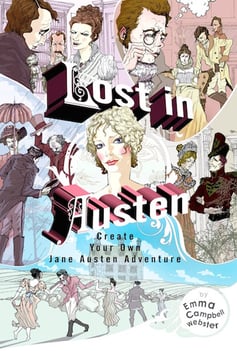
Other Works Written in Second Person Point of View
Second person is probably the rarest of the points of view. Usually writers will use second person in sections of their work to emphasize a point, rather than throughout their entire work. Here are some pieces of literature that use a second person point of view (at least in part):
- Langston Hughes’ “Hard Luck”
- Italo Calvino’s If On A Winter’s Night A Traveller
- Claudia Rankine’s Citizen: An American Lyric
- Emma Campbell Webster’s Lost in Austen: Create Your Own Jane Austen Adventure

In third person omniscient point of view, the narrator is god-like and tells the reader everything!
Third Person Omniscient Point of View
The third type of perspective you can find in literature is a third person omniscient point of view. In third person omniscient, the narrator uses third person pronouns like “he,” “she,” “they,” and “their” to refer to all the characters in the work. As a result, the narrator removes themselves as a critical character in the work (unlike the narrators that use a first or second person point of view).
Additionally, because this is a third person omniscient perspective, the narrator is given god-like qualities over the story. ( Merriam-Webster defines an “omniscient” person as someone who has “universal or complete knowledge”! ) That means the narrator can dive into any character’s head and share their thoughts and emotions with the reader. Additionally, the narrator can move around in time and place to show the reader events that the characters themselves may not be aware of! That includes jumping around from location to location, or even moving backward and forward in time.
Using a third person omniscient narrator lets an author show the reader the whole gameboard, so to speak. There’s no real limit to what a narrator can show the readers! Consequently, it allows the author to build a robust world full of well-developed characters, since the author no longer has to contend with the single-character limits of a first or second person point of view. It’s also a particularly useful technique in works with large casts of characters, since the narrator can introduce the reader to each character more quickly—and with more detail—than other points of view would allow!
Example of Third Person Omniscient Point of View: Middlemarch by George Eliot
The narrator of George Eliot’s Victorian novel, Middlemarch, is an excellent example of how a third person omniscient narrator can give readers a comprehensive view of a text. Let’s take a look at the book’s opening paragraph to see this type of point of view in action:
Remember: omniscient narrators are god-like in that they can give you more information than a single character could provide from their limited perspective. In this case, Eliot’s omniscient narrator gives us tons of information about Miss Brooke. We know that she’s beautiful but not financially well off ( the narrator calls this living in “mixed conditions”), which is reflected in her “plain garments.” Regardless, Miss Brooke is also “remarkably clever.”
Beyond that, the narrator tells us about Miss Brooke’s family by looking into her past—which is easy given that the narrator is omniscient! We learn that she and her sister, Celia, aren’t aristocratic, but they come from a good family that includes admirals, clergymen, and politicians. This helps Eliot develop characters and situations quickly, which is important in a book with a large cast of characters like Middlemarch.
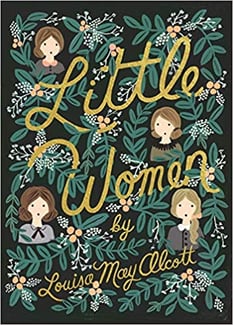
Other Works Written in Third Person Omniscient Point of View
Third person omniscient is a common point of view, especially in longer texts. Here are some examples of other works that feature an omniscient point of view:
- Louisa May Alcott’s Little Women
- Oscar Wilde’s The Importance of Being Earnest
- Nathaniel Hawthorne’s The Scarlet Letter
- Philip K. Dick’s Do Androids Dream of Electric Sheep?

In third person limited point of view, it's as if the narrator is standing behind one character's shoulder.
Third Person Limited Point of View
The last point of view an author can use is the third person limited point of view. Just like the omniscient perspective we talked about earlier, texts written in a third person limited point of view use third person pronouns to discuss characters outside of dialogue. The difference between the two is in how much information the narrator shares with the reader.
With a third person limited perspective, the narrator is limited to giving you the perspective of a single character. The narrator can peek inside the character’s head to share their thoughts, feelings, and experiences, similar to a first person point of view. Unlike first person, however, a narrator using a third person limited point of view can also zoom out to give readers a better understanding of how the character they’re following fits into the text’s plot, setting, or situation!
Here’s an easy way of understanding the difference between a first person, third person omniscient, and a third person limited point of view. Think of the narrator as a person holding a camera. You, as the reader, get to see everything the camera sees. With first person point of view, it’s like the character has had the camera implanted in their brain. You can see whatever the character looks at and nothing more. With a third person limited point of view, on the other hand, it’s like the narrator is standing behind one character and filming over his shoulde r. Not only can you get a sense of what the character is seeing, the narrator can also step back a little bit to show readers what’s going on around the character...as long as the character stays in the frame.
Third person omniscient is the most comprehensive view. It’s as if the narrator is filming from the rafters of the building. They can zoom out to show everyone for a global perspective, or they can zoom in on different events to give you a better idea of what’s happening in specific situations. So why would a writer use a third person limited point of view? Well, it’s great for situations where knowing every single detail of a story would spoil the plot. Mystery novels, for instance, often use third person limited point of view. It allows the narrator to give you the detective’s thoughts and feelings while not spoiling the whodunit! It also allows the writer to focus on developing a single character while giving readers a better view of what’s going on around that character.
Example of Third Person Limited Point of View: Harry Potter and the Sorcerer’s Stone by J.K. Rowling
Like we mentioned earlier, all texts have a point of view...which means that the Harry Potter stories do, too! Let’s look at a passage from Harry Potter and the Sorcerer’s Stone to get a better idea of how a third person limited point of view works. In this scene, Harry and his friends, Hermione and Ron, are looking through the library to learn more about the sorcerer’s stone :
It’s clear that this passage is written in third person: the narrator uses pronouns like “he,” “she,” and “them,” instead of first person pronouns like “I” or second person pronouns like “you.” But how do we know it’s third person limited? Well, we get Harry’s thoughts and feelings—like his curiosity about Nicholas Flamel—but no one else’s. We don’t know what Hermione and Ron are reading, or if they’re excited, nervous, or scared.
Rowling wrote all seven Harry Potter books using a third person limited point of view that made Harry the focal point. The narrator can tell us what Harry’s thinking, feeling, and seeing—as well as zoom out to tell us more about the precarious situations he finds himself in. But because the narrator is tied to Harry, they can’t give us a glimpse into other characters’ minds, nor can it show readers what’s happening in other parts of Hogwarts (where Harry isn’t) . That helps readers get to know Harry, even as it helps Rowling maintain the mystery around the sorcerer’s stone (or the chamber of secrets, or the half-blood prince, etc.).
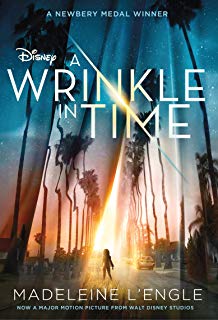
Other Works Written in Third Person Limited Point of View The third person limited point of view is a popular perspective for writers to use, so there’s no shortage of examples! Here are a few works you might be familiar with that feature a third person limited point of view:
- Samuel Taylor Coleridge’s “Christabel”
- Eudora Welty’s The Golden Apples
- Jane Austen’s Pride and Prejudice
- Madeleine L’Engle’s A Wrinkle In Time
What’s Next?
If you’re studying for the AP Literature exam, you’ll need to know about more literary devices than point of view. Why not check out our other comprehensive guides, like this one on personification ? The more familiar you are with literary terms, what they mean, and how to use them, the better your test score will be!
Did you know that there are two English AP tests? One is the literature exam, which focuses on literary analysis and comprehension. The second test is the language exam, which tests your ability to understand argument and write persuasively. Click here to learn more about the AP Language exam, how it differs from the literature exam, and what you need to do to knock it out of the park !
After you learn the fundamentals, the best way to prepare for an AP exam is to take practice tests. Check out this article on how to find the best AP practice exams , and learn how to use them to boost your score!
These recommendations are based solely on our knowledge and experience. If you purchase an item through one of our links, PrepScholar may receive a commission.

Ashley Sufflé Robinson has a Ph.D. in 19th Century English Literature. As a content writer for PrepScholar, Ashley is passionate about giving college-bound students the in-depth information they need to get into the school of their dreams.
Ask a Question Below
Have any questions about this article or other topics? Ask below and we'll reply!
Improve With Our Famous Guides
- For All Students
The 5 Strategies You Must Be Using to Improve 160+ SAT Points
How to Get a Perfect 1600, by a Perfect Scorer
Series: How to Get 800 on Each SAT Section:
Score 800 on SAT Math
Score 800 on SAT Reading
Score 800 on SAT Writing
Series: How to Get to 600 on Each SAT Section:
Score 600 on SAT Math
Score 600 on SAT Reading
Score 600 on SAT Writing
Free Complete Official SAT Practice Tests
What SAT Target Score Should You Be Aiming For?
15 Strategies to Improve Your SAT Essay
The 5 Strategies You Must Be Using to Improve 4+ ACT Points
How to Get a Perfect 36 ACT, by a Perfect Scorer
Series: How to Get 36 on Each ACT Section:
36 on ACT English
36 on ACT Math
36 on ACT Reading
36 on ACT Science
Series: How to Get to 24 on Each ACT Section:
24 on ACT English
24 on ACT Math
24 on ACT Reading
24 on ACT Science
What ACT target score should you be aiming for?
ACT Vocabulary You Must Know
ACT Writing: 15 Tips to Raise Your Essay Score
How to Get Into Harvard and the Ivy League
How to Get a Perfect 4.0 GPA
How to Write an Amazing College Essay
What Exactly Are Colleges Looking For?
Is the ACT easier than the SAT? A Comprehensive Guide
Should you retake your SAT or ACT?
When should you take the SAT or ACT?
Stay Informed
Get the latest articles and test prep tips!
Looking for Graduate School Test Prep?
Check out our top-rated graduate blogs here:
GRE Online Prep Blog
GMAT Online Prep Blog
TOEFL Online Prep Blog
Holly R. "I am absolutely overjoyed and cannot thank you enough for helping me!”
Literary Devices
Literary devices, terms, and elements, point of view, definition of point of view, point of view vs. narrator, types of point of view, first person singular.
When I try to analyze my own cravings, motives, actions and so forth, I surrender to a sort of retrospective imagination which feeds the analytic faculty with boundless alternatives and which causes each visualized route to fork and re-fork without end in the maddeningly complex prospect of my past.
First Person Plural
Most of us on the boat were accomplished, and were sure we would make good wives. We knew how to cook and sew. We knew how to serve tea and arrange flowers and sit quietly on our flat wide feet for hours, saying absolutely nothing of substance at all.
Second Person
Another uncommon point of view is second person, using the “you” pronoun to narrate the story. This point of view either implies that the narrator is actually an “I” trying to separate himself or herself from the events that he or she is narrating, or allows the reader to identify with the central character. This was popularized in the 1980s series Choose Your Own Adventure , and appears in the recent novel Pretty Little Mistakes by Heather McElhatton:
While standing in his parents kitchen, you tell your boyfriend you’re leaving. You’re not going to college. You’re not buying into the schedules, the credits, or the points. No standardized success for you.
Third Person
It is a truth universally acknowledged, that a single man in possession of a good fortune, must be in want of a wife.
Alternating Person
Some novels combine two or more of the above types of point of view. For example, some novels alternate between a first person singular point of view in some chapters and the third person point of view in other chapters. The Harry Potter series alternates between third person limited—allowing access to Harry’s thoughts—and third person omniscient when information must be shared that Harry is not witness to.
Common Examples of Point of View
Significance of point of view in literature, examples of point of view in literature, example #1: first person singular.
There must have been about two minutes during which I assumed that I was killed. And that too was interesting—I mean it is interesting to know what your thoughts would be at such a time. My first thought, conventionally enough, was for my wife. My second was a violent resentment at having to leave this world which, when all is said and done, suits me so well. I had time to feel this very vividly.
George Orwell writes about his own experiences in the Spanish Civil War in his book Homage to Catalonia . In autobiographical works, the “I” narrator is the character of the author. Here Orwell relates the experience of getting shot and the thoughts that passed through his mind directly thereafter.
Example #2: First Person Plural
It didn’t matter in the end how old they had been, or that they were girls, but only that we had loved them, and that they hadn’t heard us calling, still do not hear us, up here in the tree house, with our thinning hair and soft bellies, calling them out of those rooms where they went to be alone for all time, alone in suicide, which is deeper than death, and where we will never find the pieces to put them back together.
( The Virgin Suicides by Jeffrey Eugenides)

Example #3: Second Person
You get home to your apartment on West 12th Street. It’s a wreck. Like you. No kidding. You wonder if Amanda will ever explain her desertion. She was a model and she thought you were rich. You never spotted she was an airhead. So what does that make you?
Example #4: Third Person
The family of Dashwood had long been settled in Sussex. Their estate was large, and their residence was at Norland Park, in the centre of their property, where, for many generations, they had lived in so respectable a manner as to engage the general good opinion of their surrounding acquaintance.
The opening to Jane Austen’s Sense and Sensibility introduces the Dashwood family, and goes on to describe each character in detail. This is another example of Jane Austen using the third person omniscient point of view and gives her access to all of the character’s thoughts, desires, and motivations.
Test Your Knowledge of Point of View
2. Consider this line from William Faulkner’s As I Lay Dying :
Darl Jewel and I come up from the field, following the path in single file. Although I am fifteen feet ahead of him, anyone watching us from the cottonhouse can see Jewel’s frayed and broken straw hat a full head above my own.
3. Which of the following is an example of third person limited? A. Atticus was feeble: he was nearly fifty. When Jem and I asked him why he was so old, he said he got started late, which we felt reflected upon his abilities and manliness. ( To Kill a Mockingbird by Harper Lee) B. On the boat we sometimes lay awake for hours in the swaying damp darkness of the hold, filled with longing and dread, and wondered how we would last another three weeks. ( The Buddha in the Attic by Julie Otsuka) C. Sordo passed the wine bottle back and nodded his head in thanks. He leaned forward and patted the dead horse on the shoulder where the muzzle of the automatic rifle had burned the hide. He could still smell the burnt hair. ( For Whom the Bell Tolls by Ernest Hemingway) [spoiler title=”Answer to Question #3″] Answer: C is the correct answer.[/spoiler]
Table of Contents
Collaboration, information literacy, writing process, point of view.

What Is Point of View?
In writing, point of view refers to whether the writing takes on a singular or plural perspective in either 1st person, 2nd person, or 3rd person.
- First person is the perspective of the writer; 1st person uses words like “I,” “my,” “me,” or “we.”
- 2nd-person is the perspective of the reader being directly addressed by the writer; 2nd person uses words like “you,” “your,” or “us.” ; and
- 3rd-person is the perspective of a different party who is neither writer nor reader. 3rd person uses words like “she,” “his,” or “they.”
Point of view can typically be identified by which pronouns are used. See the chart below for a quick summary.
| First Person | I, Me, My/Mine We, Us, Our/Ours |
| Second Person | You, Your/Yours |
| Third Person | He, Him, His She, Her/Hers It, Its, They, Them, Their/ Theirs |
Related concepts: Pronouns , Perspective , First-Person Point of View , Second-Person Point of View , Third-Person Point of View
Why Does Point of View Matter?
Point of view can impact how a reader experiences a piece of writing in a wide range of ways. A writer’s choice of point of view can impact the level of formality of a piece of writing, and it can also impact how a reader feels about both the writer and the topic. Choosing to use the first person pronouns “we” and “us,” for instance, might make a reader feel in league with the writer, but in another rhetorical situation it can make readers see the writer as unserious or subjective. In fiction, a writer’s choice of point of view means deciding through whose eyes readers see a story, which in turn impacts just about every other choice a writer will make, from which information readers will get, to how they will perceive other characters and events.
How Do You Choose a Particular Point of View?
Point of view is
- a stylistic choice–i.e., choice based on the rhetor’s desired Rhetorical Stance.
- Genres tend to have very specific guidelines for point of view.
- In academic writing, e.g., writers are generally expected to use 3rd-person most of the time, with the occasional exception for 1st person if it is necessary. Using 2nd person is discouraged.
Different points of view can be applied to different writing purposes. There are far too many reasons to choose a point of view to list them all here. This list provides three common uses for the various points of view:
Common uses of 1st person
- Memoirs. Memoirs are all about someone’s personal experiences, so memoir authors use I frequently to describe what has happened to them and how they felt about it.
- Certain academic disciplines . Some academic disciplines, like women’s studies and rhetoric and composition, value the inclusion of personal experience as research material, so scholars will use I and we in their work.
Common uses of 2nd person
- Directions and Self-help books. Self-help books aim to improve their readers in some way, so the authors use you to speak directly to those readers and prompt them to reflect on themselves or take action.
- Advertisements. Advertisements target specific audiences in order to make sales, and the use of you (e.g. “Do you need cash fast?”) can prompt a viewer to identify with the ad’s target audience.
Common uses of 3rd person
- Quotes. When relaying quotations from other speakers or writers, authors will identify the source of the quotation in 3rd person, as in “He wrote that…”
- News stories. Journalism generally strives to impart objective information. By using only 3rd person, journalism avoids the overly personal tone of I and you.
Here are the common ways third person is used in an academic paper:

Note: While the above pronouns represent the third person, instead of using it , that , these , those or this , specific words or phrases will better help readers follow the writer’s logic.
How To Edit for Point of View
To identify ineffective uses of point of view, 1) identify the various points of view in your writing; and 2) decide if the points of view achieve their purpose and will not inadvertently alienate the reader.
1. Identify the various points of view in a piece of writing.
Ex: The American public is underinformed about important news from other countries. When you only watch local cable news or get your news from American websites, you miss out on reading about events like the Arab Spring and the tsunami in Japan.
In this example, the first sentence has a subject in 3rd-person point of view, the American public. The second sentence’s use of you gives it a 2nd-person point of view.
2. Decide if the points of view achieve their purpose and will not inadvertently alienate the reader.
In the first sentence, 3rd-person point of view achieves the purpose of identifying who the writer thinks is underinformed: the American public. In the second sentence, though, it is unclear what purpose the 2nd-person you is intended to achieve. Why is the writer speaking directly to me, the reader? Moreover, the writer risks alienating me by seeming to assume that I am definitely uninformed. How (potentially) offensive!
How can you correct an unnecessary shift in point of view?
- In a passage where an unnecessary shift has been noted, go through and highlight each of the point of view words.
- Change the point of view of the inconsistent pronouns to align them with the primary point of view that has already been established.
- Reread the passage aloud and listen for consistency in point of view.
Let’s look at an example:
- Even though he believed weight loss was possible, you do not know how hard it can be until you try to lose a few pounds.
- Even though he believed weight loss was possible, he did not know how hard it would be until he tried to lose a few pounds.
How do you change first or second person to third person?
Here is a table that shows several common instances of first or second person in essays and some examples of how to revise to the third person.
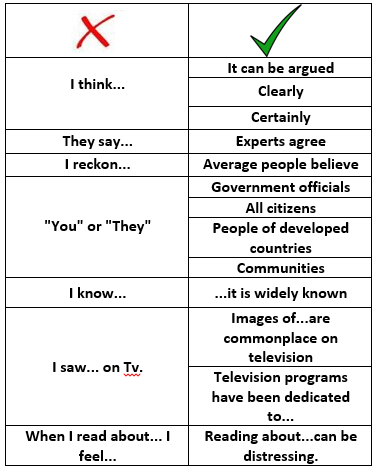
Look at the following lines and determine how you might revise them so that they remove the pronoun “you” or define the pronoun “we”:
- You can understand what it’s like to have a stack of papers to grade and only two days to do it.
- We now know that cigarettes can cause various types of cancer.
- I would like you to understand that not all students are lazy.
- We believe that gay marriage is not immoral or harmful to the American family; as such, we argue that it should be legalized.
- Doughnuts are really harmful to our health, so we should stop ingesting them.
- If you would only give reading a try, you might actually enjoy it.
- Subliminal messages enter our psyches on a daily basis.
- As a feminist, I believe that women should receive pay that is equal to that of their male coworkers.
Recommended Readings
First person.
- The First Person
- Using First Person in an Academic Essay: When Is It Okay?
Second Person
- Understanding Second Person Point-of-View: Wizard Activity
Related Articles:
First-person point of view, second-person point of view, third-person point of view, recommended.

Academic Writing – How to Write for the Academic Community

Structured Revision – How to Revise Your Work

Professional Writing – How to Write for the Professional World

Credibility & Authority – How to Be Credible & Authoritative in Speech & Writing

Citation Guide – Learn How to Cite Sources in Academic and Professional Writing

Page Design – How to Design Messages for Maximum Impact
Suggested edits.
- Please select the purpose of your message. * - Corrections, Typos, or Edits Technical Support/Problems using the site Advertising with Writing Commons Copyright Issues I am contacting you about something else
- Your full name
- Your email address *
- Page URL needing edits *
- Comments This field is for validation purposes and should be left unchanged.
Featured Articles

Point of View in Academic Writing
Point of view is the perspective from which an essay is written. The following chart lists both the personal pronouns and their possessive forms used with these points of view:
| Singular | Plural | |
| I, me (my, mine) | we, us (our, ours) | |
| you (your, yours) | you (your, yours) | |
| they, them (their, theirs) she, her (her, hers) he, him (his) it (its) one (one’s) | they, them (their, theirs) |
When choosing appropriate point of view for academic or formal writing, consider the type and purpose of the assignment.
| When using any of the three points of view, maintaining consistency is vital. Switching between points of view can be confusing for the reader. Choose a suitable perspective and then stay with it. Unclear: The accident happened right in front of so could see who was at fault. |
First Person
First-person point of view is used to write stories/narratives or examples about personal experiences from your own life. Note the following paragraph:
Several people have made a lasting impression on me . I remember one person in particular who was significant to me . Dr. Smith, my high school English teacher, helped my family and me through a difficult time during my junior year. We appreciated her care, kindness, and financial help after the loss of our home in a devastating fire.
Note : Academic writing often requires us to avoid first-person point of view in favor of third-person point of view, which can be more objective and convincing. Often, students will say, “ I think the author is very convincing.” Taking out I makes a stronger statement or claim: “The author is very convincing.”
Second Person
Second-person point of view, which directly addresses the reader, works well for giving advice or explaining how to do something. A process analysis paper would be a good choice for using the second-person point of view, as shown in this paragraph:
In order to prepare microwave popcorn, you will need a microwave and a box of microwave popcorn which you’ve purchased at a grocery store. First of all, you need to remove the popcorn package from the box and take off the plastic wrap. Next, open your microwave and place the package in the center with the proper side up. Then set your microwave for the suggested number of minutes as stated on the box. Finally, when the popcorn is popped, you’re ready for a great treat.
Note : Academic writing generally avoids second-person point of view in favor of third-person point of view. Second person can be too casual for formal writing, and it can also alienate the reader if the reader does not identify with the idea.
Replacing You
In academic writing, sometimes "you" needs to be replaced with nouns or proper nouns to create more formality or to clarify the idea. Here are some examples:
| Quality of education decreases when allow overcrowded classrooms. (Are you, the reader, allowing the conditions?) | Quality of education decreases when allow overcrowded classrooms. (Identifies who is doing what.) |
| On Saturday afternoons, usually have to stand in long lines to buy groceries. | Saturday afternoon usually have to stand in long lines to buy groceries. (Identifies who is doing what.) |
| In many states, have prisons with few rehabilitation programs. (Do you, the reader, have prisons?) | In many states, have few rehabilitation programs. (Identifies the actual subject of the sentence.) |
Third Person
Third-person point of view identifies people by proper noun (a given name such as Shema Ahemed) or noun (such as teachers, students, players, or doctors ) and uses the pronouns they, she, and he . Third person also includes the use of one, everyone, and anyone. Most formal, academic writing uses the third person. Note the use of various third-person nouns and pronouns in the following:
The bosses at the company have decided that employees need a day of in-house training. Times have been scheduled for everyone . Several senior employees will be required to make five-minute presentations. One is not eager to speak in front of others since he’s very shy. Another one , however, is anxious to relate their expertise. The variation in routine should provide an interesting day for all people concerned.
Third Person Pronouns: Gender-Fair Use of Language and Singular “They”
In the past, if you wanted to refer to one unnamed person, you used the masculine pronoun: If a person is strong, he will stand up for himself . Today, you should avoid the automatic use of the masculine pronoun because it is considered sexist language.
Also avoid perpetuating gender stereotypes by assigning a particular gendered pronoun: A doctor should listen to his patients. A nurse should listen to her patients . These examples make assumptions that doctors are men and nurses are women, which is a sexist stereotype.
Instead, use the pronouns they or them to refer to a person whose gender is undisclosed or irrelevant to the context of the usage: If a person is strong, they will stand up for themselves when they believe in something.
- AI in action
- AI in the enterprise
- Humans of AI
Words at work
- Inside Writer
- Content strategy
- Inspiration
– 6 min read
Point of view: a complete guide

Jessica Malnik
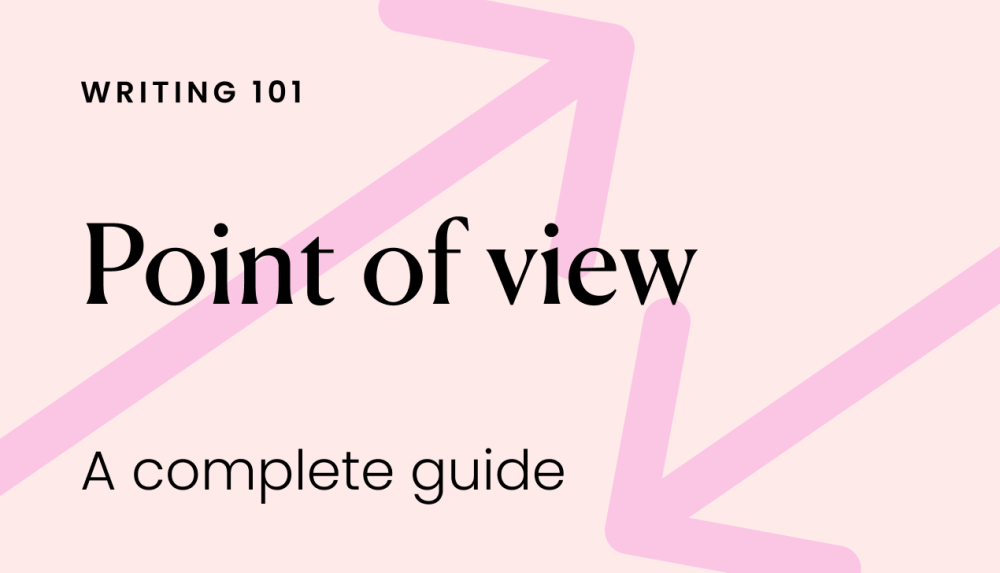
Whether you’re writing a blog post, a novel, an academic report, or a simple email to a colleague, you have a decision to make.
What point of view should you use?
Each POV has its benefits, but you’ll need to have an understanding of how they work before you can decide which one is right for your story. That’s why we’ve put together this guide.
Here, we’ll cover everything you need to know about points of view, including what they are, why they’re important, and a breakdown of the three main types. We’ll also include examples of each type of point of view so you can see the differences.
1. What is point of view?
Point of view (POV) applies when you’re talking or writing, but you’ll most likely see it referred to in fiction writing. The point of view you choose will greatly affect the storytelling process and narrative.
Point of view is essentially the perspective from which the story or narrative is being told. It answers the question of “who” is telling the story. Another way to look at it is the position from which someone or something like a scene or narrative, is being observed.
Point of view can be told from three different POVs: first-person, second-person, or third-person. We’ll dive into the specifics of these later in this post, but for now, just know there are three to choose from.
2. Why is POV important?
As mentioned above, the point of view you pick determines how a story unfolds. What do you want your audience to know? Should they “hear” what’s going on inside the heads of the characters, or should they be viewing it from an outsider’s perspective? The point of view you choose determines this.
Point of view can be used as a tool to help express feelings and thoughts. You can use it to reveal someone’s motivations or experiences. Don’t think of it as a box to check in your list of story elements; rather, consider point of view a literary device that can help your story shine.
3. Types of POV
There are three distinct points of view that you should be aware of. Each one has the potential to change the angle of your story. Here’s a bit on each POV so you can understand how they work and know when to use them in your writing.
First-person point of view
If you notice the narrator using first-person pronouns like I , me , mine , or myself , then you’re likely dealing with a story written in the first-person narrative. The first-person point of view helps the reader vicariously live out the story through the eyes of the narrator. When someone tells you a story verbally, they’ll often use this point of view to describe something they’ve witnessed themselves.
In this POV, you may have the protagonist as the main character. Meaning whoever I is — that’s who the story is about. When the protagonist is written in first-person voice, the audience gets an insight into the main character’s mind or thoughts. Sometimes this point of view is achieved through the use of journals, diaries, or letters.
Note that the first-person point of view can be used without making the story entirely about the person speaking. For instance, the narrator may tell the story in the first person, but they aren’t the ones witnessing what’s happening. They may appear to have an omniscient presence in the story or book. The person speaking may also be a minor character or unreliable in their perspective. You should never assume the person speaking in first-person voice knows everything that’s going on.
Second-person point of view
If you notice the storyteller using the pronoun you, then you’re likely reading a second-person account. This isn’t commonly used in fiction, but it can be done. One benefit to using the second-person point of view is that you can pull the reader right into the action. You don’t necessarily have to set a stage.
Keep in mind that, of the three POVs, the second-person point of view can be the most challenging to use for storytelling or fiction. This is mainly because it can feel like a gimmick or repetitive with the use of the word you . However, some stories or formats lend well to the second-person point of view. For instance, if you were writing a how-to story or “choose your own adventure” book, it absolutely makes sense to employ the second-person point of view.
Third-person point of view
If you notice the narrator utilizing pronouns like she , they , he , or it , then you’re probably reading a story written in third-person voice. This POV is often the most commonly used of the three. This is because it gives the writer more flexibility when they don’t have to write from a singular perspective. It essentially broadens the horizons of the story.
However, that’s not always the case. When writing in third-person limited, the point of view does have to be written from one character’s perspective. Often with this POV, that character is the protagonist.
On the other hand, writing in third-person multiple lets the narrator follow the perspectives of more than one character. This is where that flexibility piece plays in. The writer can switch between the different characters in the story. Even less restrictive is third-person omniscient, which allows the author to tell the story from anyone’s point of view.
4. Point of view examples
In this section, we’ll share examples of all three points of view, so you can learn to identify each.
First-person examples
Remember, first-person POV uses these pronouns:
I, my, our, we, me , us
Here are a few examples of what first person looks like:
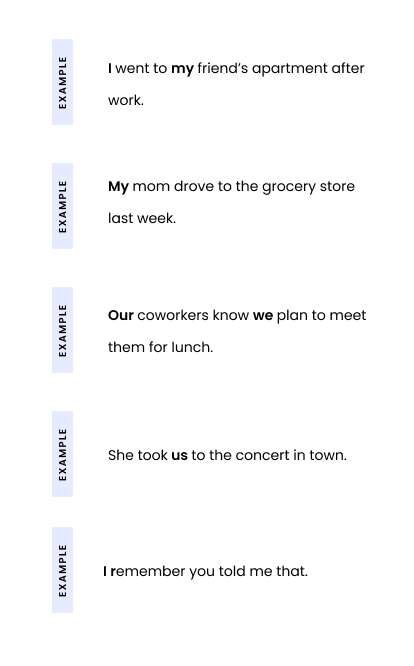
Second-person examples
Second-person POV relies on the following pronouns:
you, your, yours
Here are some examples of second-person POV in use:
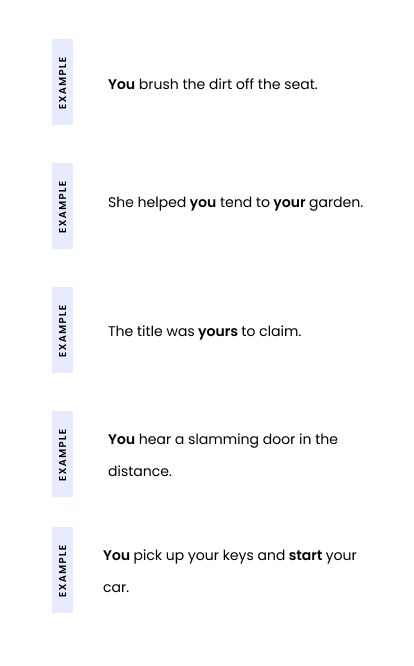
Third-person examples
You’ll see the following pronouns used for third-person POV:
she, they, he, it
Here are a couple examples of third-person POV:
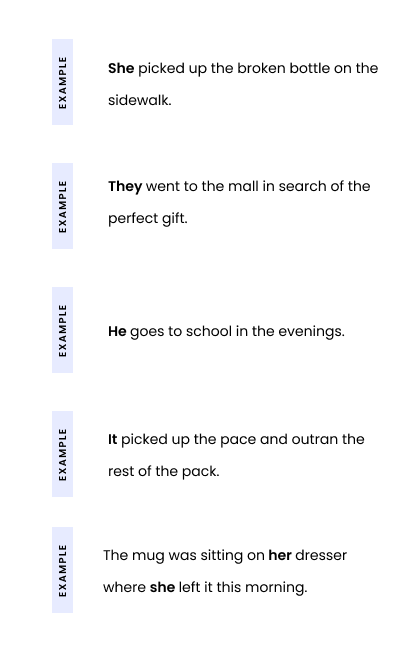
Let’s practice: One fun way to exercise your POV writing skills is to look at a common story and picture it from the three different points of view. Let’s take Cinderella, for example.
First person: I left my glass slipper at the ball last night.
Second person: You see her step out of her glass slipper and leave it at the ball.
Third person: She seemed flustered as she ran away from her glass slipper.
If you’re just getting started with storytelling or writing fiction, it helps to begin with first- or third-person voice. These offer more flexibility and are easier to work with. However, there’s no rule telling you which point of view you have to use. Consider what makes sense for your unique story. But most of all, have fun with it!
Looking for more ways to improve your writing? Start a free trial today.
--> “A wide screen just makes a bad film twice as bad.” -->
May Habib CEO, Writer.com
Here’s what else you should know about Ascending.
More resources
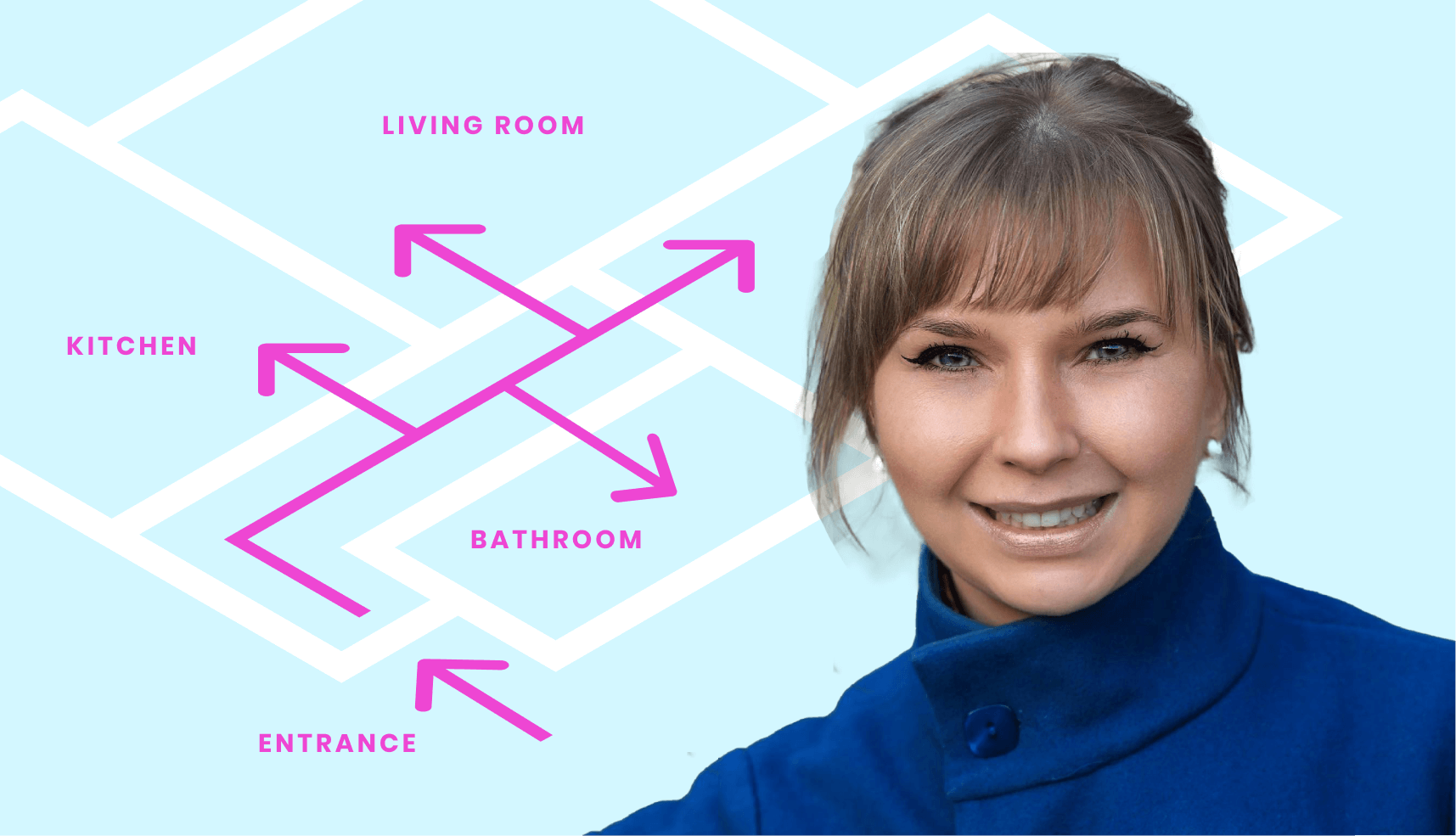
– 11 min read
Content strategy and information architecture: you can’t have one without the other

Kristin Hillery
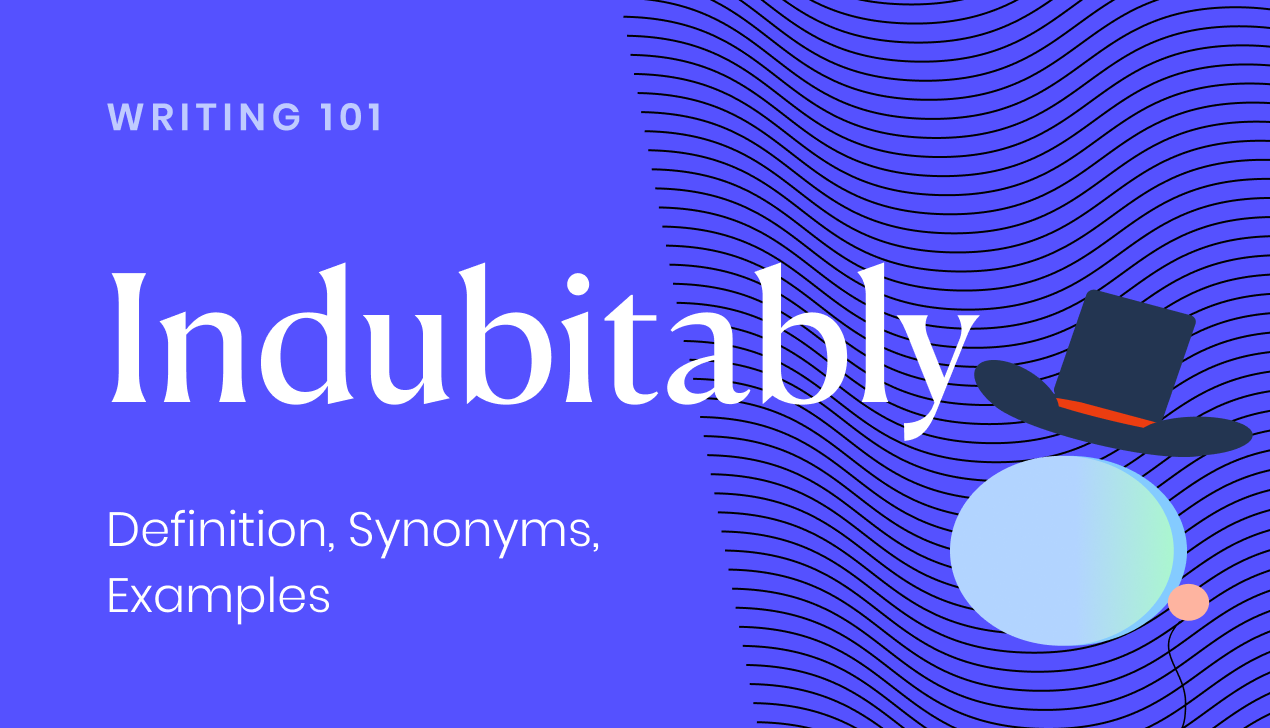
– 4 min read
Indubitably: definition, synonyms, examples

Holly Stanley
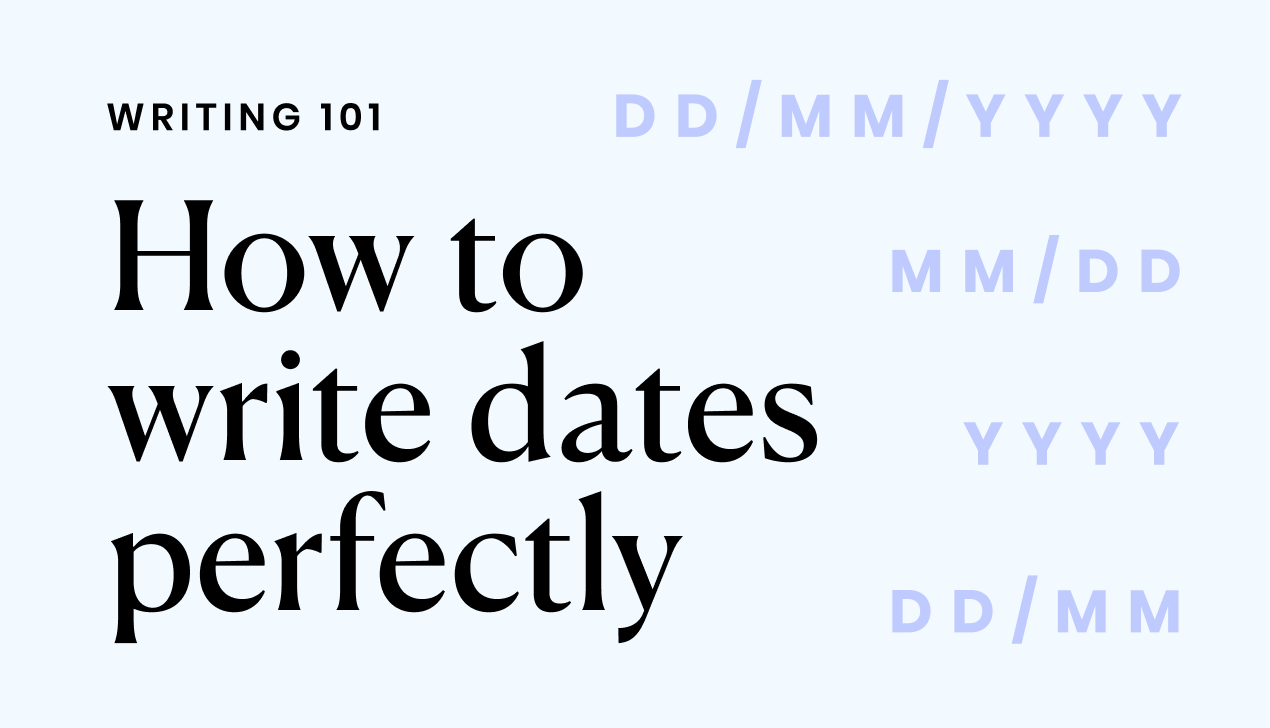
How to write dates perfectly

- Walden University
- Faculty Portal
Scholarly Voice: Point of View
Personal pronouns are used to indicate point of view in most types of writing. Here are some common points of view:
- A paper using first-person point of view uses pronouns such as "I," "me," "we," and "us."
- A paper using second-person point of view uses the pronoun "you."
- A paper using third-person point of view uses pronouns such as "he," "she," "it," "they," "him," "her," "his," and "them."
In scholarly writing, first-person and third-person point of view are common, but second-person point of view is not. Read more about appropriate points of view on the following pages:
- First-Person Point of View
- Second-Person Point of View
Pronouns Video
- APA Formatting & Style: Pronouns (video transcript)
Related Resource
Didn't find what you need? Email us at [email protected] .
- Previous Page: Varying Sentence Structure
- Next Page: First-Person Point of View
- Office of Student Disability Services
Walden Resources
Departments.
- Academic Residencies
- Academic Skills
- Career Planning and Development
- Customer Care Team
- Field Experience
- Military Services
- Student Success Advising
- Writing Skills
Centers and Offices
- Center for Social Change
- Office of Academic Support and Instructional Services
- Office of Degree Acceleration
- Office of Research and Doctoral Services
- Office of Student Affairs
Student Resources
- Doctoral Writing Assessment
- Form & Style Review
- Quick Answers
- ScholarWorks
- SKIL Courses and Workshops
- Walden Bookstore
- Walden Catalog & Student Handbook
- Student Safety/Title IX
- Legal & Consumer Information
- Website Terms and Conditions
- Cookie Policy
- Accessibility
- Accreditation
- State Authorization
- Net Price Calculator
- Contact Walden
Walden University is a member of Adtalem Global Education, Inc. www.adtalem.com Walden University is certified to operate by SCHEV © 2024 Walden University LLC. All rights reserved.
Frequently asked questions
What is a thesis statement.
A thesis statement is a sentence that sums up the central point of your paper or essay . Everything else you write should relate to this key idea.
Frequently asked questions: Writing an essay
For a stronger conclusion paragraph, avoid including:
- Important evidence or analysis that wasn’t mentioned in the main body
- Generic concluding phrases (e.g. “In conclusion…”)
- Weak statements that undermine your argument (e.g. “There are good points on both sides of this issue.”)
Your conclusion should leave the reader with a strong, decisive impression of your work.
Your essay’s conclusion should contain:
- A rephrased version of your overall thesis
- A brief review of the key points you made in the main body
- An indication of why your argument matters
The conclusion may also reflect on the broader implications of your argument, showing how your ideas could applied to other contexts or debates.
The conclusion paragraph of an essay is usually shorter than the introduction . As a rule, it shouldn’t take up more than 10–15% of the text.
An essay is a focused piece of writing that explains, argues, describes, or narrates.
In high school, you may have to write many different types of essays to develop your writing skills.
Academic essays at college level are usually argumentative : you develop a clear thesis about your topic and make a case for your position using evidence, analysis and interpretation.
The “hook” is the first sentence of your essay introduction . It should lead the reader into your essay, giving a sense of why it’s interesting.
To write a good hook, avoid overly broad statements or long, dense sentences. Try to start with something clear, concise and catchy that will spark your reader’s curiosity.
Your essay introduction should include three main things, in this order:
- An opening hook to catch the reader’s attention.
- Relevant background information that the reader needs to know.
- A thesis statement that presents your main point or argument.
The length of each part depends on the length and complexity of your essay .
Let’s say you’re writing a five-paragraph essay about the environmental impacts of dietary choices. Here are three examples of topic sentences you could use for each of the three body paragraphs :
- Research has shown that the meat industry has severe environmental impacts.
- However, many plant-based foods are also produced in environmentally damaging ways.
- It’s important to consider not only what type of diet we eat, but where our food comes from and how it is produced.
Each of these sentences expresses one main idea – by listing them in order, we can see the overall structure of the essay at a glance. Each paragraph will expand on the topic sentence with relevant detail, evidence, and arguments.
The topic sentence usually comes at the very start of the paragraph .
However, sometimes you might start with a transition sentence to summarize what was discussed in previous paragraphs, followed by the topic sentence that expresses the focus of the current paragraph.
Topic sentences help keep your writing focused and guide the reader through your argument.
In an essay or paper , each paragraph should focus on a single idea. By stating the main idea in the topic sentence, you clarify what the paragraph is about for both yourself and your reader.
A topic sentence is a sentence that expresses the main point of a paragraph . Everything else in the paragraph should relate to the topic sentence.
The thesis statement is essential in any academic essay or research paper for two main reasons:
- It gives your writing direction and focus.
- It gives the reader a concise summary of your main point.
Without a clear thesis statement, an essay can end up rambling and unfocused, leaving your reader unsure of exactly what you want to say.
The thesis statement should be placed at the end of your essay introduction .
Follow these four steps to come up with a thesis statement :
- Ask a question about your topic .
- Write your initial answer.
- Develop your answer by including reasons.
- Refine your answer, adding more detail and nuance.
An essay isn’t just a loose collection of facts and ideas. Instead, it should be centered on an overarching argument (summarized in your thesis statement ) that every part of the essay relates to.
The way you structure your essay is crucial to presenting your argument coherently. A well-structured essay helps your reader follow the logic of your ideas and understand your overall point.
The structure of an essay is divided into an introduction that presents your topic and thesis statement , a body containing your in-depth analysis and arguments, and a conclusion wrapping up your ideas.
The structure of the body is flexible, but you should always spend some time thinking about how you can organize your essay to best serve your ideas.
The vast majority of essays written at university are some sort of argumentative essay . Almost all academic writing involves building up an argument, though other types of essay might be assigned in composition classes.
Essays can present arguments about all kinds of different topics. For example:
- In a literary analysis essay, you might make an argument for a specific interpretation of a text
- In a history essay, you might present an argument for the importance of a particular event
- In a politics essay, you might argue for the validity of a certain political theory
At high school and in composition classes at university, you’ll often be told to write a specific type of essay , but you might also just be given prompts.
Look for keywords in these prompts that suggest a certain approach: The word “explain” suggests you should write an expository essay , while the word “describe” implies a descriptive essay . An argumentative essay might be prompted with the word “assess” or “argue.”
In rhetorical analysis , a claim is something the author wants the audience to believe. A support is the evidence or appeal they use to convince the reader to believe the claim. A warrant is the (often implicit) assumption that links the support with the claim.
Logos appeals to the audience’s reason, building up logical arguments . Ethos appeals to the speaker’s status or authority, making the audience more likely to trust them. Pathos appeals to the emotions, trying to make the audience feel angry or sympathetic, for example.
Collectively, these three appeals are sometimes called the rhetorical triangle . They are central to rhetorical analysis , though a piece of rhetoric might not necessarily use all of them.
The term “text” in a rhetorical analysis essay refers to whatever object you’re analyzing. It’s frequently a piece of writing or a speech, but it doesn’t have to be. For example, you could also treat an advertisement or political cartoon as a text.
The goal of a rhetorical analysis is to explain the effect a piece of writing or oratory has on its audience, how successful it is, and the devices and appeals it uses to achieve its goals.
Unlike a standard argumentative essay , it’s less about taking a position on the arguments presented, and more about exploring how they are constructed.
You should try to follow your outline as you write your essay . However, if your ideas change or it becomes clear that your structure could be better, it’s okay to depart from your essay outline . Just make sure you know why you’re doing so.
If you have to hand in your essay outline , you may be given specific guidelines stating whether you have to use full sentences. If you’re not sure, ask your supervisor.
When writing an essay outline for yourself, the choice is yours. Some students find it helpful to write out their ideas in full sentences, while others prefer to summarize them in short phrases.
You will sometimes be asked to hand in an essay outline before you start writing your essay . Your supervisor wants to see that you have a clear idea of your structure so that writing will go smoothly.
Even when you do not have to hand it in, writing an essay outline is an important part of the writing process . It’s a good idea to write one (as informally as you like) to clarify your structure for yourself whenever you are working on an essay.
Comparisons in essays are generally structured in one of two ways:
- The alternating method, where you compare your subjects side by side according to one specific aspect at a time.
- The block method, where you cover each subject separately in its entirety.
It’s also possible to combine both methods, for example by writing a full paragraph on each of your topics and then a final paragraph contrasting the two according to a specific metric.
Your subjects might be very different or quite similar, but it’s important that there be meaningful grounds for comparison . You can probably describe many differences between a cat and a bicycle, but there isn’t really any connection between them to justify the comparison.
You’ll have to write a thesis statement explaining the central point you want to make in your essay , so be sure to know in advance what connects your subjects and makes them worth comparing.
Some essay prompts include the keywords “compare” and/or “contrast.” In these cases, an essay structured around comparing and contrasting is the appropriate response.
Comparing and contrasting is also a useful approach in all kinds of academic writing : You might compare different studies in a literature review , weigh up different arguments in an argumentative essay , or consider different theoretical approaches in a theoretical framework .
The key difference is that a narrative essay is designed to tell a complete story, while a descriptive essay is meant to convey an intense description of a particular place, object, or concept.
Narrative and descriptive essays both allow you to write more personally and creatively than other kinds of essays , and similar writing skills can apply to both.
If you’re not given a specific prompt for your descriptive essay , think about places and objects you know well, that you can think of interesting ways to describe, or that have strong personal significance for you.
The best kind of object for a descriptive essay is one specific enough that you can describe its particular features in detail—don’t choose something too vague or general.
If you’re not given much guidance on what your narrative essay should be about, consider the context and scope of the assignment. What kind of story is relevant, interesting, and possible to tell within the word count?
The best kind of story for a narrative essay is one you can use to reflect on a particular theme or lesson, or that takes a surprising turn somewhere along the way.
Don’t worry too much if your topic seems unoriginal. The point of a narrative essay is how you tell the story and the point you make with it, not the subject of the story itself.
Narrative essays are usually assigned as writing exercises at high school or in university composition classes. They may also form part of a university application.
When you are prompted to tell a story about your own life or experiences, a narrative essay is usually the right response.
The majority of the essays written at university are some sort of argumentative essay . Unless otherwise specified, you can assume that the goal of any essay you’re asked to write is argumentative: To convince the reader of your position using evidence and reasoning.
In composition classes you might be given assignments that specifically test your ability to write an argumentative essay. Look out for prompts including instructions like “argue,” “assess,” or “discuss” to see if this is the goal.
At college level, you must properly cite your sources in all essays , research papers , and other academic texts (except exams and in-class exercises).
Add a citation whenever you quote , paraphrase , or summarize information or ideas from a source. You should also give full source details in a bibliography or reference list at the end of your text.
The exact format of your citations depends on which citation style you are instructed to use. The most common styles are APA , MLA , and Chicago .
An argumentative essay tends to be a longer essay involving independent research, and aims to make an original argument about a topic. Its thesis statement makes a contentious claim that must be supported in an objective, evidence-based way.
An expository essay also aims to be objective, but it doesn’t have to make an original argument. Rather, it aims to explain something (e.g., a process or idea) in a clear, concise way. Expository essays are often shorter assignments and rely less on research.
An expository essay is a common assignment in high-school and university composition classes. It might be assigned as coursework, in class, or as part of an exam.
Sometimes you might not be told explicitly to write an expository essay. Look out for prompts containing keywords like “explain” and “define.” An expository essay is usually the right response to these prompts.
An expository essay is a broad form that varies in length according to the scope of the assignment.
Expository essays are often assigned as a writing exercise or as part of an exam, in which case a five-paragraph essay of around 800 words may be appropriate.
You’ll usually be given guidelines regarding length; if you’re not sure, ask.
Ask our team
Want to contact us directly? No problem. We are always here for you.
- Email [email protected]
- Start live chat
- Call +1 (510) 822-8066
- WhatsApp +31 20 261 6040

Our team helps students graduate by offering:
- A world-class citation generator
- Plagiarism Checker software powered by Turnitin
- Innovative Citation Checker software
- Professional proofreading services
- Over 300 helpful articles about academic writing, citing sources, plagiarism, and more
Scribbr specializes in editing study-related documents . We proofread:
- PhD dissertations
- Research proposals
- Personal statements
- Admission essays
- Motivation letters
- Reflection papers
- Journal articles
- Capstone projects
Scribbr’s Plagiarism Checker is powered by elements of Turnitin’s Similarity Checker , namely the plagiarism detection software and the Internet Archive and Premium Scholarly Publications content databases .
The add-on AI detector is powered by Scribbr’s proprietary software.
The Scribbr Citation Generator is developed using the open-source Citation Style Language (CSL) project and Frank Bennett’s citeproc-js . It’s the same technology used by dozens of other popular citation tools, including Mendeley and Zotero.
You can find all the citation styles and locales used in the Scribbr Citation Generator in our publicly accessible repository on Github .
- Daily Crossword
- Word Puzzle
- Word Finder
- Word of the Day
- Synonym of the Day
- Word of the Year
- Language stories
- All featured
- Gender and sexuality
- All pop culture
- Writing hub
- Grammar essentials
- Commonly confused
- All writing tips
- Pop culture
- Writing tips
Advertisement
thesis statement
[ thee -sis steyt-m uh nt ]
- a short statement, usually one sentence, that summarizes the main point or claim of an essay, research paper, etc., and is developed, supported, and explained in the text by means of examples and evidence.
Discover More
Word history and origins.
Origin of thesis statement 1
More About Thesis Statement
What is a thesis statement .
In academic writing, a thesis statement is generally a sentence or two that summarizes the main point that an essay, research paper, or speech is making. It is typically located at the end of the introductory paragraph(s).
Thesis statements are kind of like roadmaps, laying out for the reader/listener where the writer/speaker is headed (argument) and how they are going to get there (evidence).
The thesis statement is widely taught in the humanities, especially in English classes in high school and college, to teach students how to make persuasive arguments that cite and analyze evidence and examples researched from literary, historical, or other texts.
Why is a thesis statement important in an essay?
Thesis comes from a Greek word that literally means “a setting down.” In the 300s BC, Aristotle defined thesis as when a philosopher puts forth a new idea that conflicts with general opinion.
Fast forward to today, when we use thesis to mean a “proposition” or “argument” one formally presents and defends. In academic settings, a thesis can be short for a thesis statement (our focus here) in an essay or shorter research paper. It can also be used for those much, much longer dissertations graduate students research, write, and defend for their degree (e.g., master’s thesis or doctoral thesis ).
Let’s look at statement real quick. It is a declaration or assertion. Sound redundant? The idea is that a thesis statement is the point in a paper or presentation that explicitly states the thesis. Usually in a sentence or two, the thesis statement summarizes the argument that’s going to be developed in the evidence and examples to come.
So, a thesis statement is just a sentence that gets the main point across. But, learning how to write these ain’t easy. That’s why educators, especially in English classes in high school and college, spend a lot of time teaching students how to craft effective thesis statements.
Why? Because in school, work, and life, we have to persuade people of our ideas and our point of view. These ideas might concern an analysis of literature or history, like a play by Shakespeare or a moment in the Civil Rights Movement. Or, these ideas might be a call to action, such as eating a certain diet or pursuing a business strategy.
How to write a thesis statement
There are many ways to make an effective thesis statement , but here are some general tips to follow.
So, let’s say you read a text, Shakespeare’s Twelfth Night , or researched a topic, the health benefits of kale. Then you formed an opinion about it—a claim you want to make about it and why others should care. You found evidence—quotes, examples, facts, statistics—in your resources that you think back up your argument. Your thesis statement brings all these together: point of view , evidence , and significance . It lays out where the entire paper or presentation is going, which is why educators often liken it to a roadmap .
Here’s an example:
Kale is good for you because it is nutrient-dense, cancer-fighting, and loaded with antioxidants.
The argument here—which a first-year high-schooler might make in a persuasive essay—is that “kale is good for you” (despite how some think it tastes). The claims it’s using to back up this assertion are that it’s 1) “nutrient-dense”; 2) “cancer-fighting”; and 3) “loaded with antioxidants.” The reader can expect that the rest of the essay will develop these claims, that is, cite and analyze evidence for them.
Here’s a thesis statement for a literary analysis of Shakespeare’s Twelfth Night. This resembles more of a college-level example:
Shakespeare’s Twelfth Night suggests that, when women do not reciprocate a man’s love, they are unjustly made out to be sexually deviant. This is illustrated in how the character Olivia is condemned as asexual because of her rejection of Duke Orsino.
Note how this thesis statement makes its claim in two sentences. Its argument centers on how women characters are vilified when they reject a man, and its evidence will be interactions between characters in Shakespeare’s play.
What are real-life examples of thesis statement ?
The term thesis statement is generally used by teachers and students in junior high, high school, and college, especially in English, Social Studies, and other classes in the humanities.
Okay so I rewrote my thesis statement! It’s a wee bit more vague but still a good direction a think. It’s more open so I can talk about more things and add more evidence. Wrote out an in-depth plan and then my brain crapped out. So I’m going to bed! Tomorrow is the day! — 🎃Unpaid Bills🎃 //Chaela (@Cierafire) August 14, 2019
Writing an explanatory essay in phases: thesis statement, body paragraph, concluding statement. Peer conversations to identify text evidence to support our thesis. pic.twitter.com/b6fdgx8rkD — Cheyenne England (@MsEnglandReads) August 7, 2019
The thesis statement is taught in what’s called the five-paragraph essay (or theme). This essay has an introduction which “funnels into” the thesis statement, including three reasons backing up the main argument. The next three paragraphs develop each of these claims, respectively, citing evidence and examples, such as literary texts, historical documents, or scientific reports. The final paragraph, the conclusion, restates the thesis statement and summarizes the paper and its broader significance.
Opentextbc.ca
Even after we are no longer in the classroom, people continue to reference thesis statements. While “real-life” thesis statements may not be as formal as the ones seen in five-paragraph essays, having a thesis statement —a point, a position, or a theory of the case—is considered informative, persuasive, and valuable in work, in the community, and in our personal lives.
The thesis statement is so widely taught and familiar that sometimes people joke about them. On social media, for instance, people may humorously end a post with “In this essay, I will …” when expressing a deeply felt but ultimately low-stakes opinion on some popular topic. The phrase In this essay, I will alludes to the signposting language some people use in their thesis statements.
pumpkin spice has nothing to do with pumpkins but with covering up pumpkin taste, it's a way to disassociate from the world rather than experience it, which mirrors late capitalism; in this essay I will — rachel syme (@rachsyme) August 15, 2019
Developing a Thesis Statement
Many papers you write require developing a thesis statement. In this section you’ll learn what a thesis statement is and how to write one.
Keep in mind that not all papers require thesis statements . If in doubt, please consult your instructor for assistance.
What is a thesis statement?
A thesis statement . . .
- Makes an argumentative assertion about a topic; it states the conclusions that you have reached about your topic.
- Makes a promise to the reader about the scope, purpose, and direction of your paper.
- Is focused and specific enough to be “proven” within the boundaries of your paper.
- Is generally located near the end of the introduction ; sometimes, in a long paper, the thesis will be expressed in several sentences or in an entire paragraph.
- Identifies the relationships between the pieces of evidence that you are using to support your argument.
Not all papers require thesis statements! Ask your instructor if you’re in doubt whether you need one.
Identify a topic
Your topic is the subject about which you will write. Your assignment may suggest several ways of looking at a topic; or it may name a fairly general concept that you will explore or analyze in your paper.
Consider what your assignment asks you to do
Inform yourself about your topic, focus on one aspect of your topic, ask yourself whether your topic is worthy of your efforts, generate a topic from an assignment.
Below are some possible topics based on sample assignments.
Sample assignment 1
Analyze Spain’s neutrality in World War II.
Identified topic
Franco’s role in the diplomatic relationships between the Allies and the Axis
This topic avoids generalities such as “Spain” and “World War II,” addressing instead on Franco’s role (a specific aspect of “Spain”) and the diplomatic relations between the Allies and Axis (a specific aspect of World War II).
Sample assignment 2
Analyze one of Homer’s epic similes in the Iliad.
The relationship between the portrayal of warfare and the epic simile about Simoisius at 4.547-64.
This topic focuses on a single simile and relates it to a single aspect of the Iliad ( warfare being a major theme in that work).
Developing a Thesis Statement–Additional information
Your assignment may suggest several ways of looking at a topic, or it may name a fairly general concept that you will explore or analyze in your paper. You’ll want to read your assignment carefully, looking for key terms that you can use to focus your topic.
Sample assignment: Analyze Spain’s neutrality in World War II Key terms: analyze, Spain’s neutrality, World War II
After you’ve identified the key words in your topic, the next step is to read about them in several sources, or generate as much information as possible through an analysis of your topic. Obviously, the more material or knowledge you have, the more possibilities will be available for a strong argument. For the sample assignment above, you’ll want to look at books and articles on World War II in general, and Spain’s neutrality in particular.
As you consider your options, you must decide to focus on one aspect of your topic. This means that you cannot include everything you’ve learned about your topic, nor should you go off in several directions. If you end up covering too many different aspects of a topic, your paper will sprawl and be unconvincing in its argument, and it most likely will not fulfull the assignment requirements.
For the sample assignment above, both Spain’s neutrality and World War II are topics far too broad to explore in a paper. You may instead decide to focus on Franco’s role in the diplomatic relationships between the Allies and the Axis , which narrows down what aspects of Spain’s neutrality and World War II you want to discuss, as well as establishes a specific link between those two aspects.
Before you go too far, however, ask yourself whether your topic is worthy of your efforts. Try to avoid topics that already have too much written about them (i.e., “eating disorders and body image among adolescent women”) or that simply are not important (i.e. “why I like ice cream”). These topics may lead to a thesis that is either dry fact or a weird claim that cannot be supported. A good thesis falls somewhere between the two extremes. To arrive at this point, ask yourself what is new, interesting, contestable, or controversial about your topic.
As you work on your thesis, remember to keep the rest of your paper in mind at all times . Sometimes your thesis needs to evolve as you develop new insights, find new evidence, or take a different approach to your topic.
Derive a main point from topic
Once you have a topic, you will have to decide what the main point of your paper will be. This point, the “controlling idea,” becomes the core of your argument (thesis statement) and it is the unifying idea to which you will relate all your sub-theses. You can then turn this “controlling idea” into a purpose statement about what you intend to do in your paper.
Look for patterns in your evidence
Compose a purpose statement.
Consult the examples below for suggestions on how to look for patterns in your evidence and construct a purpose statement.
- Franco first tried to negotiate with the Axis
- Franco turned to the Allies when he couldn’t get some concessions that he wanted from the Axis
Possible conclusion:
Spain’s neutrality in WWII occurred for an entirely personal reason: Franco’s desire to preserve his own (and Spain’s) power.
Purpose statement
This paper will analyze Franco’s diplomacy during World War II to see how it contributed to Spain’s neutrality.
- The simile compares Simoisius to a tree, which is a peaceful, natural image.
- The tree in the simile is chopped down to make wheels for a chariot, which is an object used in warfare.
At first, the simile seems to take the reader away from the world of warfare, but we end up back in that world by the end.
This paper will analyze the way the simile about Simoisius at 4.547-64 moves in and out of the world of warfare.
Derive purpose statement from topic
To find out what your “controlling idea” is, you have to examine and evaluate your evidence . As you consider your evidence, you may notice patterns emerging, data repeated in more than one source, or facts that favor one view more than another. These patterns or data may then lead you to some conclusions about your topic and suggest that you can successfully argue for one idea better than another.
For instance, you might find out that Franco first tried to negotiate with the Axis, but when he couldn’t get some concessions that he wanted from them, he turned to the Allies. As you read more about Franco’s decisions, you may conclude that Spain’s neutrality in WWII occurred for an entirely personal reason: his desire to preserve his own (and Spain’s) power. Based on this conclusion, you can then write a trial thesis statement to help you decide what material belongs in your paper.
Sometimes you won’t be able to find a focus or identify your “spin” or specific argument immediately. Like some writers, you might begin with a purpose statement just to get yourself going. A purpose statement is one or more sentences that announce your topic and indicate the structure of the paper but do not state the conclusions you have drawn . Thus, you might begin with something like this:
- This paper will look at modern language to see if it reflects male dominance or female oppression.
- I plan to analyze anger and derision in offensive language to see if they represent a challenge of society’s authority.
At some point, you can turn a purpose statement into a thesis statement. As you think and write about your topic, you can restrict, clarify, and refine your argument, crafting your thesis statement to reflect your thinking.
As you work on your thesis, remember to keep the rest of your paper in mind at all times. Sometimes your thesis needs to evolve as you develop new insights, find new evidence, or take a different approach to your topic.
Compose a draft thesis statement
If you are writing a paper that will have an argumentative thesis and are having trouble getting started, the techniques in the table below may help you develop a temporary or “working” thesis statement.
Begin with a purpose statement that you will later turn into a thesis statement.
Assignment: Discuss the history of the Reform Party and explain its influence on the 1990 presidential and Congressional election.
Purpose Statement: This paper briefly sketches the history of the grassroots, conservative, Perot-led Reform Party and analyzes how it influenced the economic and social ideologies of the two mainstream parties.
Question-to-Assertion
If your assignment asks a specific question(s), turn the question(s) into an assertion and give reasons why it is true or reasons for your opinion.
Assignment : What do Aylmer and Rappaccini have to be proud of? Why aren’t they satisfied with these things? How does pride, as demonstrated in “The Birthmark” and “Rappaccini’s Daughter,” lead to unexpected problems?
Beginning thesis statement: Alymer and Rappaccinni are proud of their great knowledge; however, they are also very greedy and are driven to use their knowledge to alter some aspect of nature as a test of their ability. Evil results when they try to “play God.”
Write a sentence that summarizes the main idea of the essay you plan to write.
Main idea: The reason some toys succeed in the market is that they appeal to the consumers’ sense of the ridiculous and their basic desire to laugh at themselves.
Make a list of the ideas that you want to include; consider the ideas and try to group them.
- nature = peaceful
- war matériel = violent (competes with 1?)
- need for time and space to mourn the dead
- war is inescapable (competes with 3?)
Use a formula to arrive at a working thesis statement (you will revise this later).
- although most readers of _______ have argued that _______, closer examination shows that _______.
- _______ uses _______ and _____ to prove that ________.
- phenomenon x is a result of the combination of __________, __________, and _________.
What to keep in mind as you draft an initial thesis statement
Beginning statements obtained through the methods illustrated above can serve as a framework for planning or drafting your paper, but remember they’re not yet the specific, argumentative thesis you want for the final version of your paper. In fact, in its first stages, a thesis statement usually is ill-formed or rough and serves only as a planning tool.
As you write, you may discover evidence that does not fit your temporary or “working” thesis. Or you may reach deeper insights about your topic as you do more research, and you will find that your thesis statement has to be more complicated to match the evidence that you want to use.
You must be willing to reject or omit some evidence in order to keep your paper cohesive and your reader focused. Or you may have to revise your thesis to match the evidence and insights that you want to discuss. Read your draft carefully, noting the conclusions you have drawn and the major ideas which support or prove those conclusions. These will be the elements of your final thesis statement.
Sometimes you will not be able to identify these elements in your early drafts, but as you consider how your argument is developing and how your evidence supports your main idea, ask yourself, “ What is the main point that I want to prove/discuss? ” and “ How will I convince the reader that this is true? ” When you can answer these questions, then you can begin to refine the thesis statement.
Refine and polish the thesis statement
To get to your final thesis, you’ll need to refine your draft thesis so that it’s specific and arguable.
- Ask if your draft thesis addresses the assignment
- Question each part of your draft thesis
- Clarify vague phrases and assertions
- Investigate alternatives to your draft thesis
Consult the example below for suggestions on how to refine your draft thesis statement.
Sample Assignment
Choose an activity and define it as a symbol of American culture. Your essay should cause the reader to think critically about the society which produces and enjoys that activity.
- Ask The phenomenon of drive-in facilities is an interesting symbol of american culture, and these facilities demonstrate significant characteristics of our society.This statement does not fulfill the assignment because it does not require the reader to think critically about society.
Drive-ins are an interesting symbol of American culture because they represent Americans’ significant creativity and business ingenuity.
Among the types of drive-in facilities familiar during the twentieth century, drive-in movie theaters best represent American creativity, not merely because they were the forerunner of later drive-ins and drive-throughs, but because of their impact on our culture: they changed our relationship to the automobile, changed the way people experienced movies, and changed movie-going into a family activity.
While drive-in facilities such as those at fast-food establishments, banks, pharmacies, and dry cleaners symbolize America’s economic ingenuity, they also have affected our personal standards.
While drive-in facilities such as those at fast- food restaurants, banks, pharmacies, and dry cleaners symbolize (1) Americans’ business ingenuity, they also have contributed (2) to an increasing homogenization of our culture, (3) a willingness to depersonalize relationships with others, and (4) a tendency to sacrifice quality for convenience.
This statement is now specific and fulfills all parts of the assignment. This version, like any good thesis, is not self-evident; its points, 1-4, will have to be proven with evidence in the body of the paper. The numbers in this statement indicate the order in which the points will be presented. Depending on the length of the paper, there could be one paragraph for each numbered item or there could be blocks of paragraph for even pages for each one.
Complete the final thesis statement
The bottom line.
As you move through the process of crafting a thesis, you’ll need to remember four things:
- Context matters! Think about your course materials and lectures. Try to relate your thesis to the ideas your instructor is discussing.
- As you go through the process described in this section, always keep your assignment in mind . You will be more successful when your thesis (and paper) responds to the assignment than if it argues a semi-related idea.
- Your thesis statement should be precise, focused, and contestable ; it should predict the sub-theses or blocks of information that you will use to prove your argument.
- Make sure that you keep the rest of your paper in mind at all times. Change your thesis as your paper evolves, because you do not want your thesis to promise more than your paper actually delivers.
In the beginning, the thesis statement was a tool to help you sharpen your focus, limit material and establish the paper’s purpose. When your paper is finished, however, the thesis statement becomes a tool for your reader. It tells the reader what you have learned about your topic and what evidence led you to your conclusion. It keeps the reader on track–well able to understand and appreciate your argument.

Writing Process and Structure
This is an accordion element with a series of buttons that open and close related content panels.
Getting Started with Your Paper
Interpreting Writing Assignments from Your Courses
Generating Ideas for
Creating an Argument
Thesis vs. Purpose Statements
Architecture of Arguments
Working with Sources
Quoting and Paraphrasing Sources
Using Literary Quotations
Citing Sources in Your Paper
Drafting Your Paper
Generating Ideas for Your Paper
Introductions
Paragraphing
Developing Strategic Transitions
Conclusions
Revising Your Paper
Peer Reviews
Reverse Outlines
Revising an Argumentative Paper
Revision Strategies for Longer Projects
Finishing Your Paper
Twelve Common Errors: An Editing Checklist
How to Proofread your Paper
Writing Collaboratively
Collaborative and Group Writing
- Reviews / Why join our community?
- For companies
- Frequently asked questions

Define and Frame Your Design Challenge by Creating Your Point Of View and Ask “How Might We”
Defining your design challenge is probably one of the most important steps in the Design Thinking process, as it sets the tone and guides all of the activities that follow. In the Define mode, you should end up creating an actionable problem statement which is commonly known as the Point of View (POV) in Design Thinking. You should always base your Point Of View on a deeper understanding of your specific users, their needs and your most essential insights about them. In the Design Thinking process, you will gain those insights from your research and fieldwork in the Empathise mode. Your POV should never contain any specific solution, nor should it contain any indication as to how to fulfill your users’ needs in the service, experience, or product you’re designing. Instead, your POV should provide a wide enough scope for you and your team to start thinking about solutions which go beyond status quo. Here, you’ll also learn to frame and open up your Point Of View, which is the axis that Design Thinking revolves around – a challenge well-framed is half solved.
"Your point of view should be a guiding statement that focuses on specific users, and insights and needs that you uncovered during the empathize mode. More than simply defining the problem to work on, your point of view is your unique design vision that you crafted based on your discoveries during your empathy work. Understanding the meaningful challenge to address and the insights that you can leverage in your design work is fundamental to creating a successful solution.” – d.school, Bootcamp Bootleg
Your POV is Your Guide
Your Point of View (POV) defines the RIGHT challenge to address in the following mode in the Design Thinking process, which is the Ideation mode. A good POV will allow you to ideate and solve your design challenge in a goal-oriented manner in which you keep a focus on your users , their needs and your insights about them.
You should construct a narrowly-focused problem statement or POV as this will generate a greater quantity and higher quality solutions when you and your team start generating ideas during later Brainstorm , Brainwriting , SCAMPER and other ideation sessions. In the ideation process, POV will be your guiding statement that focuses on insights and needs of a particular user, or composite character. It’s easy to get lost in the ideations sessions if you don’t have a meaningful and actionable problem statement to help keep your focus on the core essence of your research results from your previous work. A great POV keeps you on track. It helps you design for your users and their needs. If you neglect to define your POV, you may end up getting lost in the ideation processes and in your prototyping process. It’s all too easy to end up focusing on you and your company’s own needs, trying to fulfill your and your company’s own dreams, not to mention the risk of getting lost in creating amazing buttons in the beautiful colours . It’s time to find out how you define your POV.
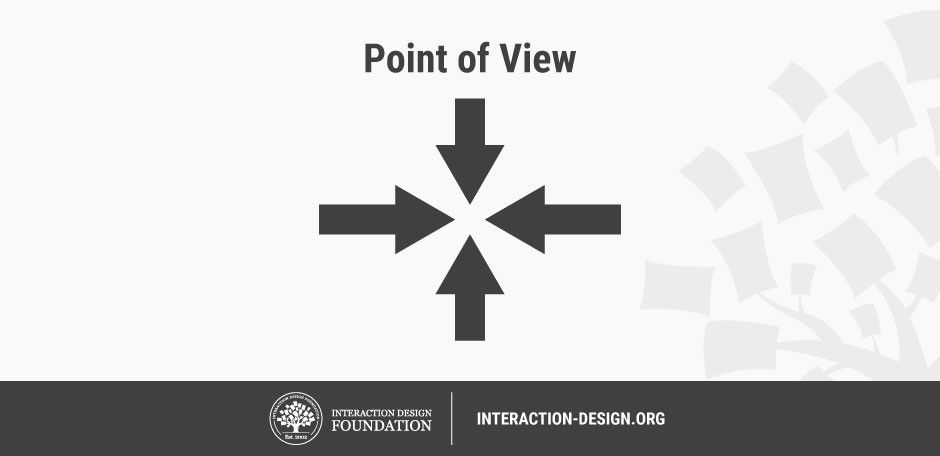
How do you Define your Point Of View?
Define the type of person you are designing for – your user . For example, you could define the user by developing one or more personas , by using affinity diagrams , empathy maps and other methods, which help you to understand and crystallise your research results – observations, interviews, fieldwork, etc.
Select the most essential needs , which are the most important to fulfill. Again, extract and synthesise the needs you’ve found in your observations, research, fieldwork, and interviews. Remember that needs should be verbs.
Work to express the insights developed through the synthesis of your gathered information. The insight should typically not be a reason for the need, but rather a synthesised statement that you can leverage in your designing solution.
Write your definitions into a Point Of View template like this one:
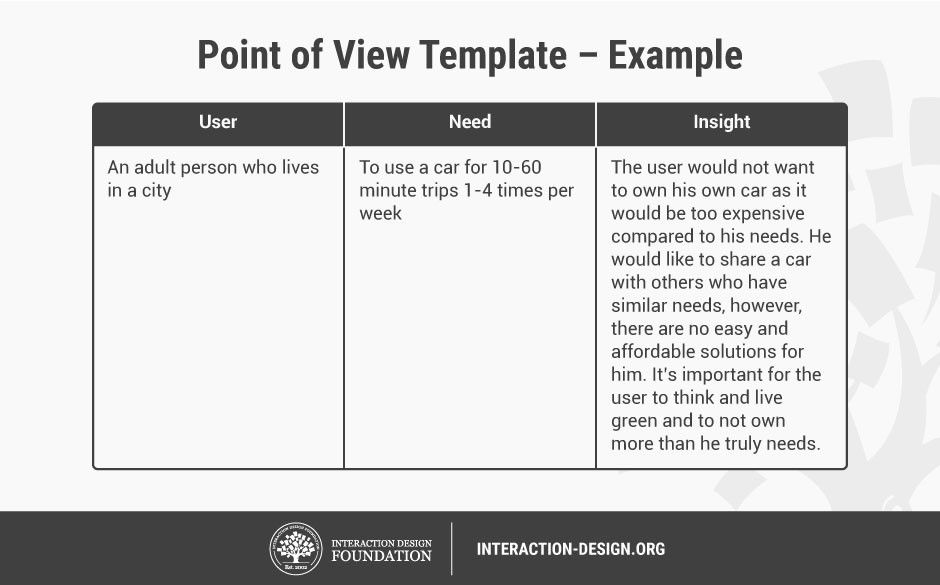
Your Point Of View template:
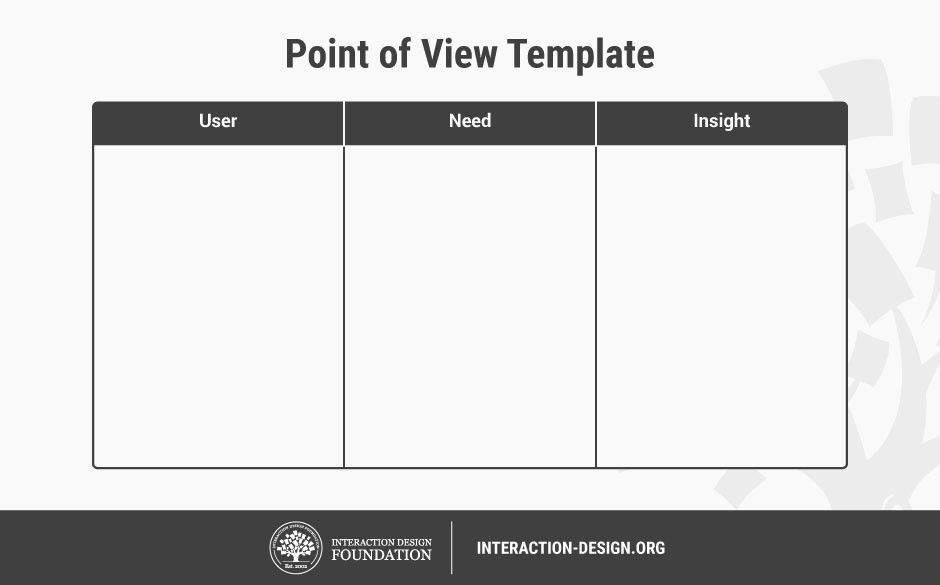
Step 3 – POV Madlib
You can articulate a POV by combining these three elements – user, need, and insight – as an actionable problem statement that will drive the rest of your design work. It’s surprisingly easy when you insert your findings in the POV Madlib below. You can articulate your POV by inserting your information about your user, the needs and your insights in the following sentence:
[ User . . . (descriptive)] needs [ Need . . . (verb)] because [ Insight . . . (compelling)]
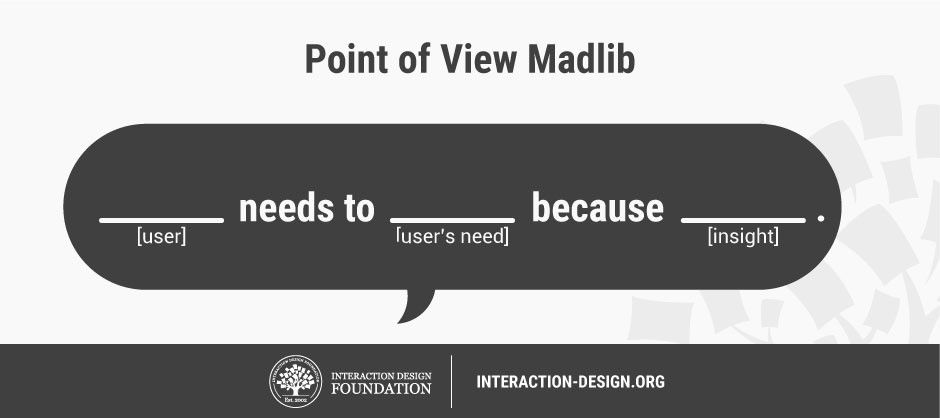
Condense your Point Of View by using this POV Madlib.
Example: An adult person who lives in the city… needs access to a shared car 1-4 times for 10-60 minutes per week … because he would rather share a car with more people as this is cheaper, more environmentally friendly, however, it should still be easy for more people to share.

Author/Copyright holder: Sam Churchill. Copyright terms and license: CC BY 2.0
You articulate a POV by combining these three elements – user, need, and insight – as an actionable problem statement that will drive the rest of your design work. An example could be: “A person who lives in the city… needs access to a shared car 1-4 times for 10-60 minutes per week … he would rather share a car with more people as this is cheaper, more environmentally friendly, and it should still be easy for more people to share.” Here you see one of Google’s driverless cars – a driverless electric car could be a part of the solution to this design challenge. However, at this stage of the design process , we’re not ready to look for solutions just yet.
Step 4 – Make Sure That Your Point Of View is One That:
Provides a narrow focus.
Frames the problem as a problem statement.
Inspires your team.
Guides your innovation efforts.
Informs criteria for evaluating competing ideas.
Is sexy and captures people’s attention.
Is valid, insightful, actionable, unique, narrow, meaningful, and exciting.
Yay! You’re now well-equipped to create a POV and it’s time to understand how to start using your POV which crystallizes all of your previous work in the Empathise mode.
You can download and print the Point Of View template here:
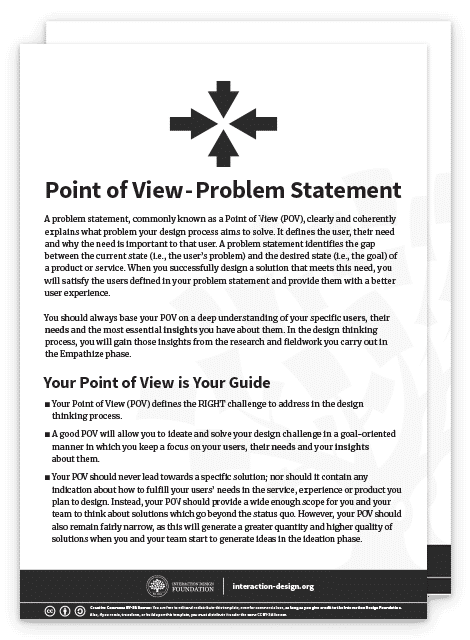
“How Might We” Questions Frame and Open Up Your Design Challenge
You start using your POV by reframing the POV into a question: Instead of saying, we need to design X or Y, Design Thinking explores new ideas and solutions to a specific design challenge. It’s time to start using the Design Thinking Method where you ask, “How Might We…?”
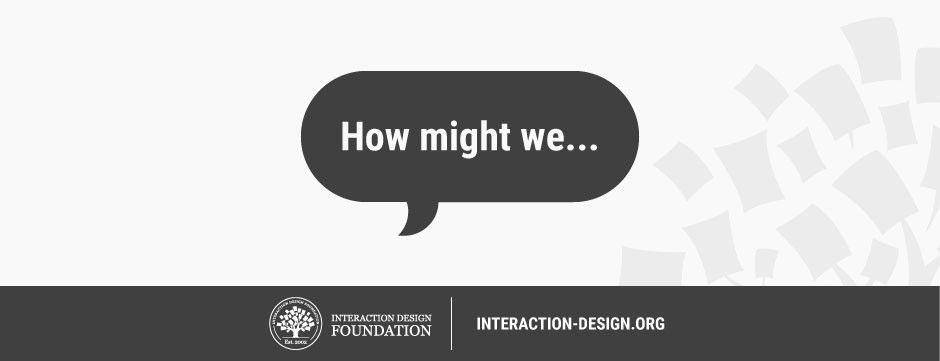
When you’ve defined your design challenge in a POV, you can start opening up for ideas to solve your design challenge. You can start using your POV by asking a specific question starting with, “How-Might-We?” or “in-what-ways-might-we?”. For example: How might we… design a driverless car, which is environmentally friendly, cheap and easy for more people to share?
How Might We ( HMW ) questions are the best way to open up Brainstorm and other Ideation sessions. HMW opens up to Ideation sessions where you explore ideas that can help you solve your design challenge. By framing your challenge as a How Might We question, you’ll prepare yourself for an innovative solution in the third Design Thinking phase, the Ideation phase. The How Might We method is constructed in such a way that it opens the field for new ideas, admits that we do not currently know the answer, and encourages a collaborative approach to solving it.
For example, if your POV is:
“Teenage girls need… to eat nutritious food… in order to thrive and grow in a healthy way.“
The HMW question may go as follows:
How Might We make healthy eating appealing to young females?
How Might We inspire teenage girls towards healthier eating options?
How Might We make healthy eating something, which teenage girls aspire towards?
How Might We make nutritious food more affordable?
These are simple examples, all with their own subtle nuances that may influence slightly different approaches in the ideation phases. Your HMW questions will ensure that your upcoming creative ideation and design activities are informed with one or more HMW questions, which spark your imagination and aligns well with the core insights and user needs that you’ve uncovered.
“We use the How Might We format because it suggests that a solution is possible and because they offer you the chance to answer them in a variety of ways. A properly framed How Might We doesn’t suggest a particular solution, but gives you the perfect frame for innovative thinking.” – Ideo.org
How Might We?
The How Might We question purposely maintains a level of ambiguity, and opens up the exploration space to a range of possibilities. It's a re-wording of the core need, which you have uncovered through a deeper interrogation of the problem in your research phase, the Empathise mode in Design Thinking – and synthesized in the Define mode in Design Thinking.
"How" suggests that we do not yet have the answer. “How” helps us set aside prescriptive briefs. “How” helps us explore a variety of endeavors instead of merely executing on what we “think” the solution should be.
"Might" emphasizes that our responses may only be possible solutions, not the only solution. “Might” also allows for the exploration of multiple possible solutions, not settling for the first that comes to mind.
"We" immediately brings in the element of a collaborative effort. “We” suggests that the idea for the solution lies in our collective teamwork.
Without a statement of a clear vision or goal, “How Might We” is obviously meaningless. The words require a well-framed objective, a POV, which is neither too narrow so as to make it overly restrictive, nor too broad so as to leave you wandering forever in infinite possibilities.
An Inspiring HMW example
David and Tom Kelley's book Creative Confidence has the story of the Embrace Warmer , a design challenge undertaken by Stanford Graduate Students aimed at solving the problem of neonatal hypothermia, which costs the lives of thousands of infants in developing countries every year. Faced with the situation where hospital incubators were too expensive as well as physically inaccessible to villagers who lived in rural settings, a team of students engaged in some Empathy research, which led them to formulate the HMW statement:
"How Might We create a baby warming device that helps parents in remote villages give their dying infants a chance to survive?"
This HMW question inspired the design of the Embrace Warmer sleeping bag device, which provides the warmth premature babies in rural villages need, and which they are able to access at a fraction of the cost of traditional hospital incubators.
Whilst a traditional approach may have resulted in technological attempts to reduce the cost of the incubator, empathic research revealed that one of the core issues was the inability or unwillingness of mothers to leave their villages or leave their babies at hospitals for extended periods. This resulted in the reframing of an incubator to a warming device.

Expand on Your How Might We Questions
Marty Neumeier's Second Rule of Genius is all about framing and opening up your Point Of View by helping us dream of wishing for what we want. To start wishing, ask yourself the kinds of questions that begin with:
How might we...? (This is the commonly structured framing phrase used to express the essence of the challenge at hand.)
In What Ways Might We…. (Expand on HMW to add the possibility of multiple ways.)
What's stopping us from...?
In what ways could we...?
What would happen if...?
From there, you can ask follow-up questions such as:
Why would we...?
What has changed to allow us to...?
Who would need to...?
When should we...?
“When you let your mind wander across the blank page of possibilities, all constraints and preconceptions disappear, leaving only the trace of a barely glimpsed dream, the merest hint of a sketch of an idea.” – Marty Neumeier's Second Rule of Genius
Best Practice Guide to Asking How Might We
Begin with your Point of View (POV) or problem statement. Start by rephrasing and framing your Point Of View as several questions by adding “How might we” at the beginning.
Break that larger POV challenge up into smaller actionable and meaningful questions. Five to ten How Might We questions for one POV is a good starting point.
It is often helpful to brainstorm the HMW questions before the solutions brainstorm.
Look at your How Might We questions and ask yourself if they allow for a variety of solutions. If they don’t, broaden them. Your How Might We questions should generate a number of possible answers and will become a launchpad for your Ideation Sessions, such as Brainstorms.
If your How Might We questions are too broad, narrow them down. You should aim for a narrow enough frame to let you know where to start your Brainstorm, but at the same time, you should also aim for enough breadth to give you room to explore wild ideas.
You can download and print out our How Might We template which you and your team can use as a guide:
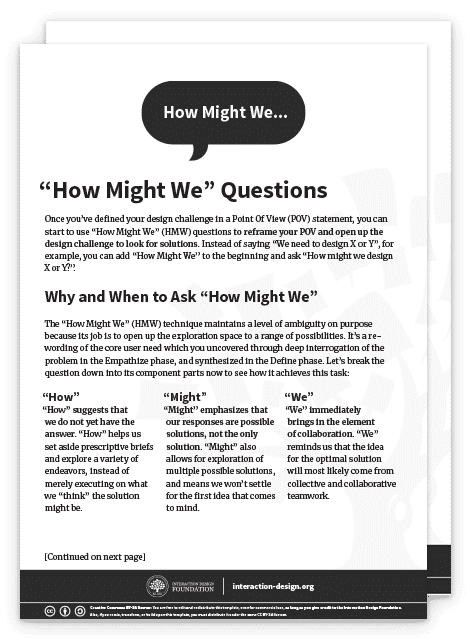
A Good POV will Make Your Problem Statement Human-Centred
Creating your POV will help you to define the problem as a problem statement in a human-centered manner. A human-centered problem statement is important in a Design Thinking project because it guides you and your team, and focuses on the uncovered specific needs. It also creates a sense of possibility and optimism in that it encourages team members to generate ideas during the Ideation stage, the third and next stage in the Design Thinking process. A good problem statement should thus have the following traits. It should be:
Human-centred. This means you frame your problem statement according to specific users, their needs and the insights that your team has gained during the Empathise phase. Rather than focus on technology, monetary returns or product specifications, the problem statement should be about the people the team is trying to help.
Broad enough for creative freedom. This means the problem statement should not focus too narrowly on a specific method regarding the implementation of the solution. Neither should the problem statement list technical requirements, as these would unnecessarily restrict the team and prevent them from exploring areas that might bring unexpected value and insight to the project.
Narrow enough to make it manageable. On the other hand, a problem statement such as “Improve the human condition” is too broad and will likely cause team members to feel easily daunted. Problem statements should have sufficient constraints to make them manageable.
Linear Problem Solving vs. the Non-Linear Nature of Design Thinking
This design challenge framing is in stark contrast to the business models for linear problem solving, which rationally attempt to define everything upfront, and then etch away at achieving the set solution systematically. Design Thinking is also very systematic, but its approach is more about uncovering the problem rather than etching away at a set solution. Idris Mootee mentions in his book, Design Thinking for Strategic Innovation, that more than 80% of management tools, systems, and techniques are for value capture, but that the role of Design Thinking is for value creation.
Well-framed Challenges
A well-framed challenge has just enough constraints, with space to explore. You might have encountered the following linear problem-solving approach by your manager telling you: "Design a poster which increases sign-ups to our next event."—or—"Redesign the packaging so our product is more noticeable on the shelf." These kinds of briefs quite often attempt to solve the problem of target markets not responding well enough to what's on offer, and are attempts to put a patch on things. Design Thinking digs deeper and helps us understand the users, their needs and our insights about them before we decide upon which course of action to take. As such, Design Thinking will instead help us ask and research: “Why are people not signing up for the event?” and “What is it about our product that causes people to ignore it?”
Design Thinking helps us focus on what kind of users we’re dealing with, their needs we're trying to address in our design challenge, and then understand whether we're actually addressing those needs well enough.
Define and re-define – The Non-Linear Nature of Design Thinking
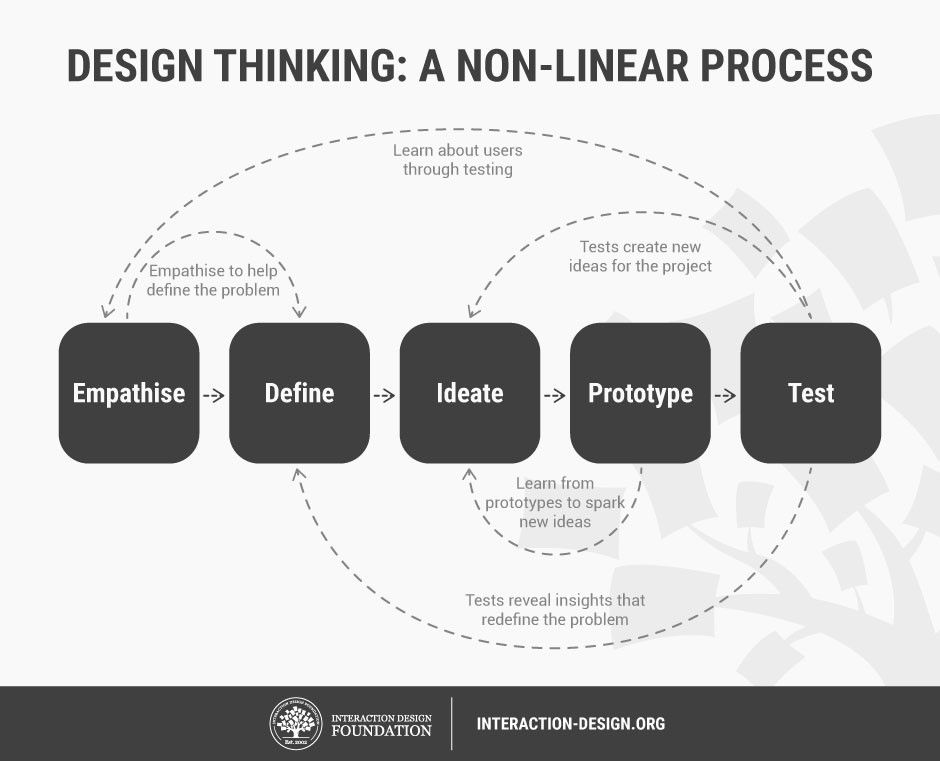
The five stages of Design Thinking are not sequential steps, but different “modes” you can put yourself in, to iterate on your problem definition, ideas, or prototype, or to learn more about your users at any point during the project. It is important to be aware from the outset that the initial definition of your challenge is based upon your initial set of constraints or understandings, and that you should revisit and re-frame your definition often as you uncover new insights indicating a problem in the framing as you work in the other four Design Thinking modes .
Know Your History
One of the most commonly structured framing phrases which we use to express the essence of the challenge at hand is: How Might We? (HMW). The Phrase is rumoured to have been popularized by Min Basadur at Proctor and Gamble, then on to IDEO, next at Google and later at Facebook in a viral breakout, that has since revolutionised how companies frame their innovation challenges. GK Van Platter of Humantific references a much earlier example in an article entitled, Origins of How Might We? (2012). The reframing technique has its roots all the way back in the mid-sixties, with a work by Sidney J. Parnes Ph.D "Creative Behavior Guidebook", which touches on the concept of "Invitation Stems" or "How Mights" .
The Take Away
Spend enough time to carefully consider the format and composition of your POV and HMW questions to ensure that your upcoming creative ideation and design activities are informed with one of more HMW questions, which spark your imagination and align well with the core insights and user needs that you’ve uncovered. Creating your POV helps you define your problem statement in a human-centred manner.
“If I had an hour to solve a problem I'd spend 55 minutes thinking about the problem and 5 minutes thinking about solutions.” – Albert Einstein
References & Where to Learn More
Idris Mootee, Design Thinking for Strategic Innovation: What They Can't Teach You at Business or Design School, 2013
Ideo.org, How Might We .
Marty Neumeier, The Rules of Genius #2, Wish for what you want , 2014.
Sarah Soule: How Design Thinking Can Help Social Entrepreneurs , 2013.
Warren Berger, The Secret Phrase Top Innovators Use , 2012.
Hero Image: Author/Copyright holder: Simon Powell. Copyright terms and licence: CC BY 2.0
Design Thinking: The Ultimate Guide

Get Weekly Design Tips
Topics in this article, what you should read next, the 5 stages in the design thinking process.

- 1.8k shares
What is Design Thinking and Why Is It So Popular?

- 1.6k shares
Personas – A Simple Introduction

- 1.5k shares
Stage 2 in the Design Thinking Process: Define the Problem and Interpret the Results

- 1.3k shares
What is Ideation – and How to Prepare for Ideation Sessions

- 1.2k shares
Affinity Diagrams: How to Cluster Your Ideas and Reveal Insights

- 2 years ago
Stage 4 in the Design Thinking Process: Prototype

- 3 years ago
Stage 3 in the Design Thinking Process: Ideate

- 4 years ago
Stage 1 in the Design Thinking Process: Empathise with Your Users

Empathy Map – Why and How to Use It

- 3 weeks ago
Open Access—Link to us!
We believe in Open Access and the democratization of knowledge . Unfortunately, world-class educational materials such as this page are normally hidden behind paywalls or in expensive textbooks.
If you want this to change , cite this article , link to us, or join us to help us democratize design knowledge !
Privacy Settings
Our digital services use necessary tracking technologies, including third-party cookies, for security, functionality, and to uphold user rights. Optional cookies offer enhanced features, and analytics.
Experience the full potential of our site that remembers your preferences and supports secure sign-in.
Governs the storage of data necessary for maintaining website security, user authentication, and fraud prevention mechanisms.
Enhanced Functionality
Saves your settings and preferences, like your location, for a more personalized experience.
Referral Program
We use cookies to enable our referral program, giving you and your friends discounts.
Error Reporting
We share user ID with Bugsnag and NewRelic to help us track errors and fix issues.
Optimize your experience by allowing us to monitor site usage. You’ll enjoy a smoother, more personalized journey without compromising your privacy.
Analytics Storage
Collects anonymous data on how you navigate and interact, helping us make informed improvements.
Differentiates real visitors from automated bots, ensuring accurate usage data and improving your website experience.
Lets us tailor your digital ads to match your interests, making them more relevant and useful to you.
Advertising Storage
Stores information for better-targeted advertising, enhancing your online ad experience.
Personalization Storage
Permits storing data to personalize content and ads across Google services based on user behavior, enhancing overall user experience.
Advertising Personalization
Allows for content and ad personalization across Google services based on user behavior. This consent enhances user experiences.
Enables personalizing ads based on user data and interactions, allowing for more relevant advertising experiences across Google services.
Receive more relevant advertisements by sharing your interests and behavior with our trusted advertising partners.
Enables better ad targeting and measurement on Meta platforms, making ads you see more relevant.
Allows for improved ad effectiveness and measurement through Meta’s Conversions API, ensuring privacy-compliant data sharing.
LinkedIn Insights
Tracks conversions, retargeting, and web analytics for LinkedIn ad campaigns, enhancing ad relevance and performance.
LinkedIn CAPI
Enhances LinkedIn advertising through server-side event tracking, offering more accurate measurement and personalization.
Google Ads Tag
Tracks ad performance and user engagement, helping deliver ads that are most useful to you.
Share Knowledge, Get Respect!
or copy link
Cite according to academic standards
Simply copy and paste the text below into your bibliographic reference list, onto your blog, or anywhere else. You can also just hyperlink to this article.
New to UX Design? We’re giving you a free ebook!

Download our free ebook The Basics of User Experience Design to learn about core concepts of UX design.
In 9 chapters, we’ll cover: conducting user interviews, design thinking, interaction design, mobile UX design, usability, UX research, and many more!
New to UX Design? We’re Giving You a Free ebook!

IMAGES
VIDEO
COMMENTS
The thesis (pronounced thee -seez), also known as a thesis statement, is the sentence that introduces the main argument or point of view of a composition (formal essay, nonfiction piece, or narrative). It is the main claim that the author is making about that topic and serves to summarize and introduce that writing that will be discussed ...
A thesis statement: tells the reader how you will interpret the significance of the subject matter under discussion. is a road map for the paper; in other words, it tells the reader what to expect from the rest of the paper. directly answers the question asked of you. A thesis is an interpretation of a question or subject, not the subject itself.
Point of view refers to the perspective that the narrator holds in relation to the events of the story. The three primary points of view are first person, in which the narrator tells a story from their own perspective ("I went to the store"); second person , in which the narrator tells a story about you, the reader or viewer ("You went to the ...
Step 2: Write your initial answer. After some initial research, you can formulate a tentative answer to this question. At this stage it can be simple, and it should guide the research process and writing process. The internet has had more of a positive than a negative effect on education.
A strong thesis is specific, precise, forceful, confident, and is able to be demonstrated. A strong thesis challenges readers with a point of view that can be debated and can be supported with evidence. A weak thesis is simply a declaration of your topic or contains an obvious fact that cannot be argued.
Conclusion. Analyzing an author's purpose and point of view is a skill that empowers you to unlock the hidden meanings within texts. By understanding why authors write the way they do and recognizing their unique perspectives, you can gain valuable insights into the world of written communication.
Third person point of view can be omniscient, meaning the narrator can see and know everything within the story, or limited, meaning the narrator is restricted in what they see and know of the story. Here are some well-known examples of literary works with third person point of view: Beloved. Lord of the Flies. Little Women.
Thesis. Your thesis is the central claim in your essay—your main insight or idea about your source or topic. Your thesis should appear early in an academic essay, followed by a logically constructed argument that supports this central claim. A strong thesis is arguable, which means a thoughtful reader could disagree with it and therefore ...
Examples of Point of View. Sandra Cisneros wrote a story called "Eleven." The point of view is the perspective of 11-year-old Rachel. The story takes place at school during her birthday and is about her humiliation of receiving an old sweater. Throughout the story, she speaks in the first-person point of view, sharing her thoughts as events ...
A thesis is an in-depth research study that identifies a particular topic of inquiry and presents a clear argument or perspective about that topic using evidence and logic. Writing a thesis showcases your ability of critical thinking, gathering evidence, and making a compelling argument. Integral to these competencies is thorough research ...
A good thesis has two parts. It should tell what you plan to argue, and it should "telegraph" how you plan to argue—that is, what particular support for your claim is going where in your essay. Steps in Constructing a Thesis. First, analyze your primary sources. Look for tension, interest, ambiguity, controversy, and/or complication.
But the narrator of a text and the point of view of a text are two different things. The narrator is who is telling the story. In contrast, a text's point of view is the perspective the story is being told from. If you think of the narrator as a person, their point of view is the angle they're taking on the story.
The narrator of a story can be a participant in the story, meaning this character is a part of the plot, or a non-participant. The point of view in a story refers to the position of the narrator in relation to the story. For example, if the narrator is a participant in the story, it is more likely that the point of view would be first person ...
In writing, point of view refers to whether the writing takes on a singular or plural perspective in either 1st person, 2nd person, or 3rd person. First person is the perspective of the writer; 1st person uses words like "I," "my," "me," or "we.". 2nd-person is the perspective of the reader being directly addressed by the writer ...
Point of view is the perspective from which an essay is written. The following chart lists both the personal pronouns and their possessive forms used with these points of view: Singular. Plural. First Person. I, me (my, mine) we, us (our, ours) Second Person. you (your, yours)
Point of view can be used as a tool to help express feelings and thoughts. You can use it to reveal someone's motivations or experiences. Don't think of it as a box to check in your list of story elements; rather, consider point of view a literary device that can help your story shine. 3. Types of POV.
Point of View. This guide includes instructional pages on scholarly voice. Point of View. are used to indicate point of view in most types of writing. Here are some common points of view: A paper using first-person point of view uses pronouns such as "I," "me," "we," and "us." A paper using second-person point of view uses the pronoun "you."
The thesis statement is essential in any academic essay or research paper for two main reasons: It gives your writing direction and focus. It gives the reader a concise summary of your main point. Without a clear thesis statement, an essay can end up rambling and unfocused, leaving your reader unsure of exactly what you want to say.
Thesis statement definition: a short statement, usually one sentence, that summarizes the main point or claim of an essay, research paper, etc., and is developed, supported, and explained in the text by means of examples and evidence.. See examples of THESIS STATEMENT used in a sentence.
A thesis statement . . . Makes an argumentative assertion about a topic; it states the conclusions that you have reached about your topic. Makes a promise to the reader about the scope, purpose, and direction of your paper. Is focused and specific enough to be "proven" within the boundaries of your paper. Is generally located near the end ...
The first person point of view tells the story from the perspective of the author or narrator. Because of that, it uses first person pronouns like "I," "we," "my," "mine," "our," and "ours.". Second person point of view, on the other hand, tells the story while addressing the reader directly. It uses second-person ...
Defining your design challenge is probably one of the most important steps in the Design Thinking process, as it sets the tone and guides all of the activities that follow. In the Define mode, you should end up creating an actionable problem statement which is commonly known as the Point of View (POV) in Design Thinking. You should always base your Point Of View on a deeper understanding of ...